#no i know i live in a political hub and being unique is like. bad apparently but really
Explore tagged Tumblr posts
Text
i am once again baffled by the inability of people to start conversations on dating apps
#relationships dont start in vacuums yall you gotta... interact....#ask questions share opinions like#either the people in this city specifically are abysmal at this or they're all BORING AS HELL#no i know i live in a political hub and being unique is like. bad apparently but really#i didn't know it was this bad#still convinced im going to wind up channelling my great aunt living to 100 never marrying and spending my entire life just Being Rad
0 notes
Text
Dick Grayson x Mercenary Reader HCs Part 1
a/n: This is basically a Dick Grayson/ Reader thingy that has been stuck in my head for months but I haven’t plotted out an actual fic for. Basically, I have the relationship mapped out in my head but I have no scenarios. I was hoping someone could suggest a plot I can play with. This part is mostly platonic with hints of a future relationship. This is pretty much in a weird version of canon running around in my head.
masterlist
You’re Deathstroke’s apprentice. (This version is the version from the Knights and Dragons movie so he isn't a complete and utter asshole. Look, I just really like that version.) Let's just say you had more moxie than self preservation. It also helps that you’re a meta with a pretty unique power. Anything drawn on your skin turns into a physical object. (You basically have a bunch of permanent markers on you in addition to your usual equipment.)
Dick doesn't like you because of your profession but has a grudging respect for your skill. You think Dick is annoying for getting in the way but you understand that he's just trying to do his best to help the city in his own useless way.
YOU LORDING YOUR HEIGHT OVER DICK WHEN YOU'RE KIDS AND YOU QUIETLY CURSING WHEN YOU STOP GROWING.
You and Dick never set out to be friends. You honestly had no clue when this even started. Maybe it was because you keep accidentally saving each other or maybe because you two have a lot to bond over such as murdered parents and emotionally inept mentors.
When it actually started: You, in full costume, recognize your least favourite bird and see that he's crying and that he not only has an ugly bruise in his face but also a bunch of other injuries. you simply sit with him and throw your arms around him letting your muscles relax as if to tell him ‘it's ok and that you’ve got him’. You let him cry into your shoulder. You understand that you have a little more in common than he's willing to admit. You use one of your motion tattoo wings as a cover from the rain and the other to keep Dick warm. When Dick finally calms down enough to think, he's jarred by how nice you are acting. your general demeanor loosened at this point you let your offense show and the very petulant look on your face draws a tired laugh out of Dick. your angry look melts to give way to something resembling relief. You stay there for a while not speaking before Dick decides he needs to leave. Without a fuss you let him go.
After that, instead of fighting each other during encounters, you two kind of just sit together and start talking about what happened since your last encounter. Or you two play rock, paper, scissors to see who ‘won’.
Dick realizes that your personality is hilariously incompatible with your chosen profession. You rant about how Slade lectures you about learning how to lie better and when they tested how bad you were at it Dick was sure Alfred would politely word it as wooden. you had good control over your body language but you had a look caught between pain and annoyance etched on your face.
Mini scenario:
Dick is really stressed out with school and vigilanteing and with Bruce that he just starts wandering around Gotham.
It was a bad idea. Wandering around Gotham is generally a bad idea especially if your head isn't on straight but there is something relaxing about just wandering around.
Dick ends up at one of Gotham's old movie theatres. One of those businesses that you're pretty sure is a front for something because you can't wrap your head around how they could possibly still be in business.
Then there you were a foot from the ticketing windows. His mind instantly recognizes you. You, in turn, recognize him instantly.
When neither of you launch into an attack, you decide to watch a movie together. After bickering for 15 minutes about what movie you should watch, you decide on a coin toss. Because you won, Dick was subjected to your love of terrible movies.
You go out for burgers afterwards and joke about the movie. You complain about the bad acting and the ridiculous story line. You even come up with how they should have done it.
Your lunch was spent outside in the parking lot of the burger joint.
You walk around some more after you explain that you haven't been to this part of Gotham and Dick gives you a mini tour.
You talk about a mix of mundane teenager things and some complaints about their occupations.
You check your watch and explain that you need to go to the grocery store for ingredients.
Dick goes with you just because. He won't admit that he's having a lot of fun.
Being teenagers they fuck around. Being exceptionally athletic and intelligent teenagers you fuck around entertainingly.
At first, you play 'the price is right' because Dick wants to prove he isn't a spoiled rich kid. He doesn't prove jack. You don't do much better but it's on the opposite end.
You get bored and frustrated so you start a scavenger hunt much to the terror of the other customers. How would you feel about 2 terrors zooming around screaming about butter and backflipping over you?
Dick is busy gloating about his victory when the store gets robbed. Dick can't do anything because right now he is a rich boy extraordinaire and should not be capable of fighting. you on the other hand is sore from losing and just yeets a can into one of the robbers faces.
Everyone's attention pans to your as you ready to lob another can at them. The robbers run leaving their unconscious friend on the floor bleeding.
You still pay for the can but ask Dick to get another one.
Walking down the street, Dick notices how many take out places are on the way and asks why you don't just eat from there. you simply tell him you like home cooking more. He notes that for next time.
You exchange phone numbers so you can plan a next time.
The next time they hang out you both bring homemade snacks to sneak into the theater.
They start hanging out in civvies and do really mundane civilian stuff you want to try and that Dick doesn't get to do enough.
You become a sort of hub of normality for Dick. He can talk to you about all the weird stuff without worrying about your not getting it or your judging him while also doing the most mind numbingly human things.
What do they usually talk about:
Casual nerdy stuff
Weird history shit you reads about
Vigilante stuff
Funny henchman stories from the perspective of a vigilante and a higher level henchman
Sometimes they talk about trauma but they only vaguely mention it
They debate over dumb things like whether there's too much variety in cereal. Guess who's on which side.
Sometimes they discuss fighting techniques.
Dick teaches you Romani and about the Romani culture
You sometimes explains various myths and superstitions from your own culture
Dick sometimes talks about school and galas and you end up making fun of weird rich people. They also end up making fun of the various rich people who hire you.
You'll talk about almost everything with each other
You bring him to one of your safe houses for a home cooked meal after he tells you how he lives off of cereal. You were horrified.
The Titans, Batman, and Alfred get really suspicious about Dick's new civilian friend.
Slade gets suspicious of you frequently visiting certain cities.
Somehow they figure out that you are the wraith.
They all lecture Dick about it.
Slade just finds the whole thing amusing and debates on whether he can actually convince you to give up some of Grayson's secrets.
I just love the image of them casually hanging out in civvies with Batman questioning Dick's life decisions and what your has been influenced by his relationship with Catwoman while Deathstroke and Wintergreen are just quietly amused by the situation at some point they were worried about you discussing merc stuff but neither talk about current business unless it's safe to.
Wintergreen isn't particularly worried since Grayson is a good kid. Wintergreen once joked that you should convince him to join their side. You said that Dick didn't have the right personality to be a merc. The irony of this was completely lost on your.
You spending a ton of your hard earned mercenary money to win a stuffed toy that you think little Rose would want. Dick making fun of you for not getting it then he ends up spending too much money but he eventually gets it. You and Dick pass by a shop and you see the exact same stuffed toy in the shop window for a sixteenth of the fortune you spent at the arcade. Good news though, Rose still has the stuffed toy.
Both of you being petty at dance dance revolution.
When you rant to each other in less than private areas, you rapidly switch languages.
Unbeknownst to Slade, Dick actually knows a bunch of his safe houses and unbeknownst to Dick, those are Deathstroke's safe houses. You are technically not lying when you say it's yours.
You have a silent pact not to blow each other's covers unless they deem it completely necessary (when people's lives are at stake). The only person who knows this pact is Jason and they have bought his silence.
You will both go out of their way to help each other out of a bind.
Sometimes when Bruce and Alfred are out of town and the stars align to have you visiting for a job, you end up helping Dick babysit. Jason gets confused and defensive at first. You have dealt with distrustful youngins. Neither Rose nor Joey wanted anything to do with you at first. You, however, grew up wanting siblings so you tried your darndest to look after them and it is really fucking hard to not let this munchkin grown on you.
When you're old enough to hit the club they often go drinking together. You once tried to have you wingman for Dick. Using the ‘fantastic’ negotiating skills you got from mercenary work, you ended up getting the number for yourself. You once told Rose and Joey about it and both of them made lighthearted jokes about it.
Dick gets confronted by Slade at sword point and asks what his intentions are with his kid (He honestly isn't at all serious but he likes how scared Dick got because the man is terrifying.)
Dick also gets interrogated by Joey and Rose because, you know, this is their big sister.
You often insist on family dinners at least once every 2 weeks with your siblings, sometimes with their mom (Adeline is kind of not ok with you and Rose being present but is trying her best for Joey's sake), sometimes with their dad, occasionally with their uncle Wintergreen.
You usually just casually call Slade 'pops' and you drawls 'dad' when you’re pissed and 'papa' when you’re emotional. You try your damndest to only call him Slade or Deathstroke on the field but sometimes you slip up and calls him pops in the field
You have batnapped each batkid at least once. Batnapping meaning seeing a baby bat and throwing them over your shoulder when you’re pretty sure they’re going to get killed. This isn’t limited to kids. You still do this when they’re adults. The image of you throwing Dick over your shoulder when you two were tiny gives me life but you throwing Dick and/or Jason over your shoulder when they’re huge has me cackling.
You basically accidentally become a de facto big sister/ mom friend to the batkids purely through your friendship with Dick.
Images from this scenario I can’t get out of my head:
Stargazing
Teaching Dick how to cook. He just ends up going to your place for a meal though.
Running around during a rain storm huddled under a jacket with Dick because neither of you checked the weather
Casual affection you two share because you’re both tactile people. Casual affection as in just sitting on the couch in each other’s space, bumping shoulders to communicate, leaning on each other, hugging each other when greeting each other, and all that good stuff.
---------------------------------------------------------------------------------------------------------
Thanks for reading! I’m really sorry for the grammar and disorganization.
If you guys are interested in the more bickering dialogue heavy part 2 either comment here or send an ask or pm me. *shrugs* This is just really self indulgent on my part.
taglist:
@idkmanicantenglish
@birdy-bat-writes (I will stop tagging you when you run out of good ideas for me.)
#dick grayson x reader#dick grayson x you#dick grayson imagine#dick grayson#Deathstroke#parental#Slade Wilson#BatFam#batfamily headcanon#rant#my writing#merc!reader#batboys#batkids
196 notes
·
View notes
Text
The East Asian Origins of the Fire Nation and Its Villains

Introduction
Over the years, many volumes of fandom blood have been spilled from discussions concerning the Fire Nation’s main villains, Ozai and Azula. Paralleling this have been arguments over their relationships with Zuko, Iroh, Ursa, Mai, Ty Lee, with each other, even with themselves. Since Ozai and Azula are the figureheads of the Fire Nation that Zuko must peacefully restore the honor of, it is worthwhile understanding why people “like them” are considered proper leaders of the current Fire Nation.
Most of these discussions have sought to create “theories” that explain these characters as exclusively combinations of mental illness, personality disorders and various emotional traumas.
A couple examples of these discussions are the essays “Azula, the Embodiment of Jealousy and Neglect,” and “Three Pillars Theory of Azula.” These two essays are just examples, but they capture the widespread strategy the fandom has employed in trying to understand the motivations and goals of Ozai and Azula and their various relationships with the other characters. In addition, the shouting matches between Azula “fans” and “haters” also illustrates these discussions. Since the franchise has yielded so few hard answers, these importance of these discussions has not waned.
What these discussions focus on, as represented by those essays, are the characters’ apparent emotional problems, theoretical moral compasses and perceived inadequacies in the eyes of their families. Typically, the “lens” these discussions view these villains through is one that tries to relate them to present day spousal and domestic abuse narratives, namely as being both “abuser” and “victim” in a cycle of abuse that can be related to the modern, real world.
What these conversations do not provide are adequate explanations for how the historical, political, military and cultural aspects of the Fire Nation molded these military leaders. You would think that people with “Lord” and “Princess” in their names, who train daily for warfare and hand-to-hand combat, would make their responsibilities take center stage in their lives.
While there is a place for “nitty gritty” psychological examinations for understanding certain behaviors, trying to depict the Fire Nation villains as purely allegories of modern day domestic abusers, empathy deficient bullies and people afflicted by personality disorders eliminates Avatar’s most unique and defining characteristic: its East Asian origins.
You don’t need beautiful animation, martial arts-styled bending and immersion in a fantasy world to explain how families in the modern era can hurt their children for petty reasons. We have that in our own lives. We have friends and families who have experienced that. It can be addressed in any other setting. It can be addressed in Avatar but it doesn’t need Avatar to address it.
What we don’t experience in our modern lives is ancient China 2000 years ago, or feudal Japan after the takeover of the Tokugawa Shogun, or religious monks living in their temples in the mountains untouched by the modern world, and so on.
The setting of Avatar is one of both beauty and relative detachment from the real (and modern) world, but it is one that is based on a period of history and human civilization that most of Avatar’s audience (North America and Europe) have little exposure to. If the characters’ motivations are too detached from the fictional world in which they live (i.e. by ignoring the historical, political, military and cultural context), then you begin to lose the world’s depth. At the same time, if their motivations are too connected to the present world, then all Avatar is is a visual motif of ancient East Asia.
By seeking to explain the Fire Nation villains as embodiments of modern psychology’s understanding of “bad” people, you erase the opportunity to apply East Asia’s very real history of warfare, monarchical domination and oppressive cultures to a fictional world that is trying to say something about that warfare, monarchical domination and oppressive cultures. Note that the show did in fact achieve this with the Dai Lee’s corruption and manipulation of the Earth King; it depicted loosely the very real occurrence of Chinese Emperors being “kept in the dark” by their advisors so as not to interfere with the “real” governing of the states.
If your goal is to view Avatar purely as an allegory for modern dysfunctional relationships and domestic abuse, you lose Avatar’s uniqueness as a fictional dive into an East Asian-inspired world, especially one that is ravaged by warfare and feudalism.
In this article, I describe an alternative model for understanding the Fire Nation’s culture and history, and how its politics and military molded its heroes and villains.
What We Know and Might Know
In order to fill the gaps in our knowledge of the Fire Nation, we first have to understand what is both known about the Fire Nation and what can be reasonably presumed about it.
First, what do we know about the Fire Nation?
1. The Fire Nation is an archipelago with a history spanning thousands of years.
2. The Fire Nation was originally the “Fire Islands” and was not initially governed by a central power.
3. The Fire Islands had a unified cultural and religious authority in the form of the “Fire Sages”.
4. Eventually, the Fire Islands were unified by a single power—the “Imperial Government”—and afterward became known as the “Fire Nation”.
5. The Imperial Government is headed by a supreme ruler: the “Fire Lord”.
6. The Fire Lord is a hereditary monarch whose family is considered the “Royal Family”, both of which are separate entities from the Fire Sages.
7. The Fire Sages remain a distinct entity from the Imperial Government.
8. Both the Fire Lord and Royal Family are military and administrative rulers.
9. The Fire Lord and their Royal Family are not sacred and everlasting; their power can be “challenged” by rival leaders.
10. Fire Lords are expected to “show their worth” and be competent fighters in their own right; prowess in military arts and control of subordinates are valued traits.
11. Agni Kais are a longstanding component of Fire Nation culture.
12. The Fire Nation experienced an “unprecedented time of peace and wealth” during the era of the Fire Nation, not during the era Fire Islands.
Next, what can be reasonably presumed given what we know?
Something necessitated the Fire Islands becoming unified, but this unification did not result in the Fire Sages taking power, nor did it yield a peaceful, democratic government.
The Imperial Government that resulted from this unification is rooted in military control and maintaining the fealty of its subjects; in Avatar and the Fire Lord, Sozin put on his “ruler persona” to Roku initially before acting friendly, only later to demand loyalty from him as if Roku was any other subject.
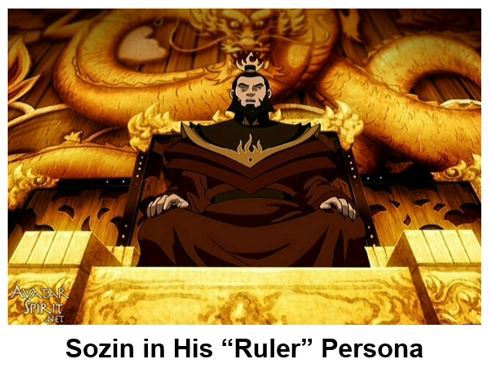
The culture of the Fire Nation values strength and bravery from its firebenders, as explained in an official description of Agni Kais. Presumably, the Agni Kai predates the era of the Fire Lord and has been used to settle disputes of various kinds. This could be interpreted as a “non-destructive” means of avoiding war and greater loss of life given how easily firebenders could wreak havoc to wooden buildings and crops (among other flammable components of society). Since nobody recognized Zuko on Ember Island in The Beach, despite his obvious scar, severe scars from burns must be common enough in the Fire Nation that a teen boy having one on his face is not horrifying nor particularly unattractive.

Presumably, the Fire Nation/Fire Islands used to hold its religion and spiritual ties in higher regard, but Sozin’s start of the war required this aspect of the Fire Nation to be suppressed, as implied by dragon hunting and the divided loyalties of the Fire Sages at Roku’s temple, and the fact that various generals and admirals have defected. At the same time, vast enough swaths of the country and its leadership did follow Sozin’s path, considering that he and his family remained in power for over a hundred years. If Fire Lords can have their power challenged, then either nobody tried to stop Sozin, or they were defeated. Azula’s comment about “rumors of plans to overthrow him (Ozai)” in The Avatar State implies betrayal of the Royal Family is not a dormant threat. Though she was technically lying, it must have been a credible lie since neither Iroh and Zuko thought it was preposterous; his brother being “regretful” is what puzzled Iroh, not that there would be plots against the Fire Lord.
Notably, the Fire Lord’s throne room changed between the start of the war and the present day. Prior to Sozin, it did not have the imposing wall of flame as it does now. Certainly it had to be rebuilt after Roku destroyed it, but the wall of flame is much more imposing than the old.
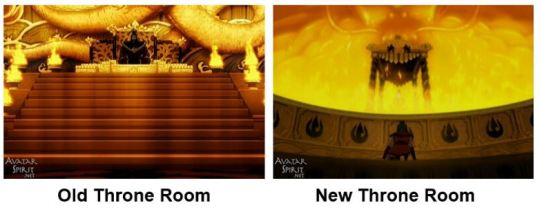
The Fire Sages still pay a role in the Fire Nation, but this role is not known. Presumably, they play some part in the succession of the Fire Lord since they preside over coronation. Perhaps the relationship between the Fire Lord and Fire Sages is similar to the relationship between the Japanese Emperor and the Shoguns, where the Shoguns held the true power in the country (military and administrative) whereas the Emperor maintained a facade of power as a cultural and religious symbol. What is known about the Fire Sages is that they have a temple in the capital and are divided between their loyalties to the Avatar and the Fire Lord.
Finally, the Imperial Government’s capital is located in an isolated, fortified city inside a volcano’s caldera, where coming-and-going is strictly controlled. The city is large, full of nobility, physically disconnected from the external port city (versus directly being the hub of economic activity) and contains numerous underground bunkers.

Why would the Capital require such extensive bunkers and fortifications? Presumably because the Fire Lord and Royal Family can be “challenged” and the bunkers are a defense mechanism against both external and internal threats. The Fire Nation did have a “darkest day” tied to solar eclipses, which suggests that the loss of firebending had profound military consequences. Whatever the reasons, the Imperial Government is so concerned about its survival that it has constructed massive fortifications around its capital, implying that warfare is a major concern.
Areas of Confusion
But what does all of this mean?
Was the Fire Nation previously peace-loving and compassionate while Sozin is responsible for all of its “evils”?
Have Agni Kais been performed for centuries and so Zuko being challenged to one was neither unusual nor particularly grotesque for the Fire Nation’s culture?
Did Sozin face massive opposition to starting the war or was everyone humbly obedient to the Fire Lord?
How is a Fire Lord’s rule challenged?
Why wasn’t Sozin overthrown if he had to “impose” the war upon the country?
Why did the Fire Lord come to existence in the first place?
Why has the Imperial Government not been replaced by the Fire Sages?
Why does the Fire Nation need a national government?
What is a more compelling explanation for the Fire Nation’s villains other than mental illness and personality disorders?
As it turns out, there is a way to understand the Fire Nation that adequately fills in the gaps, explains its heroes and villains and provides a lesson on East Asian history.
A Brief History of Ancient Japan’s Unification
The islands of Japan have been populated for tens of thousands of years, but the “modern” era of warlords and emperors did not begun until the past 1500 years or so. While the Japanese people were not united under a single state, there was an “Emperor” who was believed to have been descended from a goddess. Despite this first emperor having control over a certain portion of Japan, it did not take long until the country split into separate feudal states.
While the Emperor never went away, their power over the country waned. The real power in Japan laid in the hands of the various feudal lords (daimyo), who used their armies to defend their territories and capture new ones from other lords.
Since the Emperor represented a shared cultural connection among the people, their power was not completely absent. In the earlier parts of history, before the Emperor became completely subordinated, the Emperor would appoint a Seii Taishōgun, or supreme commander, of the Emperor’s armies. Eventually, this “supreme commander” became the actual ruler of the Japan since they controlled the military. By appointing them “shogun” they more or less had the public approval of the Emperor despite the Emperor not actually being able to control them.
Various shoguns came and went, but through it all were the daimyo using their samurai to battle for control of the country. Ruthlessness and murder were common. Building alliances only to later betray them were often wise tactics. For a thousand years, the rulers of Japan lived by the sword, died by the sword and used it to maintain their power. Things got particularly bad during the Sengoku Period, which is considered the “Warring States” period of Japan. That tells you all you need to know.

It was during this time that one of these feudal lords rose to power, a man named Tokugawa Ieyasu (first name Ieyasu, last name Tokugawa). Using a combination of political tact, military genius and European steel breast armor, he defeated all other daimyo during the Azuchi–Momoyama period and installed himself as the shogun of the Tokugawa Shogunate. This marked the end of over a thousand years of continuous violence and social turmoil in Japan.

The Tokugawa Shogunate represented Japan’s first unified national government. The country’s existing daimyo were placed under strict control to ensure they did not rebel. The military was nationalized and the existing feudal governments rearranged to ensure centralized control by the Shogun in his capital at Edo. Notably, Edo became modern day Tokyo.
National laws were written, along with cultural and religious standards to ensure social cohesiveness, stability and control. The economies of Japan also flourished, especially in the cities. A consequence of the Tokugawa Shogunate, however, was closing off Japan to the outside world. The Shogun wanted to ensure their rule and control of the populace. Allowing other countries to influence them and provide assistance to competing powers within the country was viewed as destabilizing.
A particularly unique aspect of the Tokugawa’s politic strategy was requiring the daimyos’ families to live in the capital while the daimyo themselves had to go back and forth between their homes in their territory (called a domain) and their homes in the capital every other year. The Shogun essentially held the daimyos’ families hostage to ensure they would not rebel or work against him, although they lived in the comfort and relative freedom of a modern city, not as actual prisoners.

Another tactic the Shogun utilized to quell rebellion was to keep careful control of who entered the city of Edo and its surroundings. Guards were at all entrances and major roads and registries were kept of all people. Essentially, if you weren’t suppose to be somewhere, you weren’t allowed to be there.
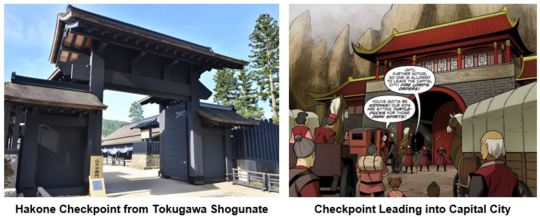
Bushdio also developed during this period as way of controlling the warrior class, and was much more complicated than most Western depictions. With war and feudal fighting no longer a constant threat, the samurai class became enforces for the new government. Naturally, the Shogun was particularly interested in controlling them.
Control is a common theme of the Tokugawa Shogun’s government.
The Tokugawa Period was one of peace and stability, prosperity and enjoyment of the arts, but Ieyasu Tokugawa was not a nice person. He hunted down and executed the families of rival clans, including kids, during the takeover. He held families hostage and made sure his subordinates feared him and never stepped out of line. He enacted strict laws to control the populace and made sure no one could challenge him and his government’s reign. And it worked. Japan did not experience another war until the end of the Tokugawa Shogunate 278 years later, when the Emperor regained control and ended the era of isolationism. There’s a reason why modern day Japan doesn’t view this period with derision and loathing; given the context of the time, it was a proud moment for a region racked by warfare and division.
A pattern is beginning to emerge: an island nation ruled by feuding lords with no central power to direct them; a religious and cultural figure with no real power; a period of intense warfare and turmoil followed by a lasting period of unification and prosperity; a powerful central government headed by a hereditary monarch who took power using ruthlessness and military might; a hereditary monarch who rules through fear and demands fealty; a capital city with strict control of who comes and goes.
Themes of control and subordination from a central power.
This is sounds very familiar.
The Military and Political History of the Fire Nation
The history of ancient Japan provides a real-world model for understanding the origins of the Fire Nation’s Imperial Government, the Fire Lord and why they rule through fear and military domination. Keep in mind that the Fire Nation is not Japan, but warfare, centralized control and a desire for peace and stability are universal. Ancient Japan’s experience with feudalism, warfare and the eventual peace that came from having a competent central authority can go a long way in applying Avatar’s “East Asian origins” to the Fire Nation and its villains and heroes.
Using the rise of the Tokugawa Shogunate as a template, the history of the Fire Nation looks like this:
The Fire Islands were ruled by various feudal lords. These feudal lords engaged in warfare with each other as they vied for ever increasing control. Firebending was the primary source of these lords’ military might. The Fire Sages were recognized as spiritual and religious leaders by the Fire Islands people, but they did not have the practical power necessary to enforce peace upon the lands.

At the same time, firebending was recognized as being fundamental to the influence of the Fire Sages and the power of the feudal lords. Since fire can destroy houses, burn fields, melt iron and lay waste to non-bending armies, whoever can control and weaponize firebending for their own purposes will attain the most power. On the other hand, this also makes warfare particularly destructive as even small rebellions could lay waste to cities given how much fire a single firebender can unleash.
At some point, in order to put a stop to the fighting, a central authority came to power, either as one of those warlords or a Fire Sage acquiring enough military and political power. Maybe an avatar helped them. Without a doubt, military might had to have played a role in ending the “Warring States” period of the Fire Islands.
In order to make sure the Fire Islands did not fall back into fighting and remained peaceful and stable, this new central authority created a sweeping national government to control them. Thus are the beginnings of the Fire Lord and Imperial Government.
Because the Fire Nation is full of people with ”desire and will, and the energy and drive to achieve what they want” (in the words of Uncle Iroh), the destructive capacity inherent to a nation full of firebenders must be kept under strict control; if the goal is to create a prosperous, flourishing society, you cannot allow it to be destroyed periodically by walking flamethrowers.
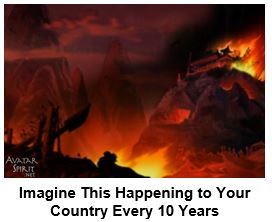
As a result, the Imperial Government is not a “friendly” entity. It controls the nobility and lords who act as the local “vassals” in their home territories; it amasses a large, overwhelming military to quash any attempts at rebellion, and to send a clear message to its people to not even try; it uses fear and threats of violence to control the people who might feel the “drive and willpower” to try their hand at acquiring wealth and power through force.
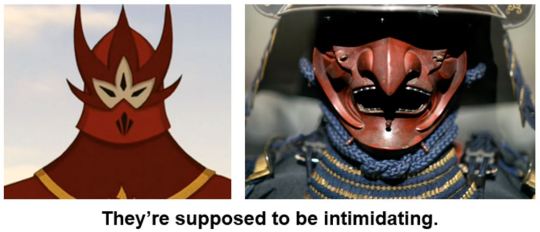
The Agni Kai exists as a means of settling conflict without the destructive consequences of firebending. Perhaps a Fire Lord enacted this to further tamp down on firebenders’ destructive tendencies. It may also be an example of how the Fire Nation’s “warrior class” handles internal disputes in a similar manner as bushido.
Bravery, ferocity and a willingness to fight are valued in the leadership of the country because the Imperial Government is supposed to be a military entity first; how can the Fire Lord, their family and government inspire fear in the people if the people don’t believe they will be crushed if they step out of line?
At the same time, since the Fire Nation is much smaller than the Earth Kingdom, the Fire Lord must ensure they can defend the Fire Nation from invasion; you need a large, devoted, competent military to go up against an enemy multiple times your size.
In order to further control the country, the Fire Lord requires the families of the lords and nobility to live in the closed-off, guarded capital inside the caldera in a similar manner as the Tokugawa Shogunate required. This is why the capital is so guarded and closed-off, yet beautiful and comfortable; it is both a defensive measure for the administrative officials and a means of holding the nobility “hostage”.
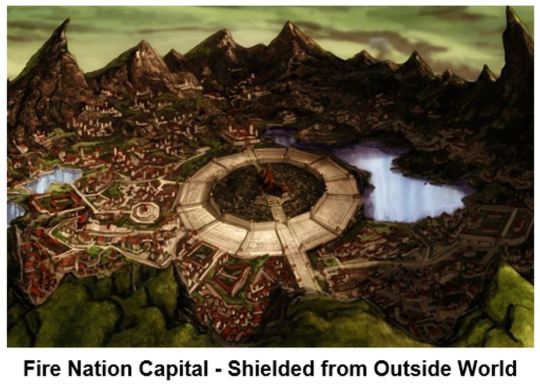
The Fire Lord and Royal Family views themselves as presiding over, and maintaining the peace and stability of the Fire Nation. Their responsibility is to ensure that the peaceful Fire Nation does not fall back into the chaotic Fire Islands. Being nice and democratic is not their means of achieving this; making sure everybody subordinates themselves to the Imperial Government is.
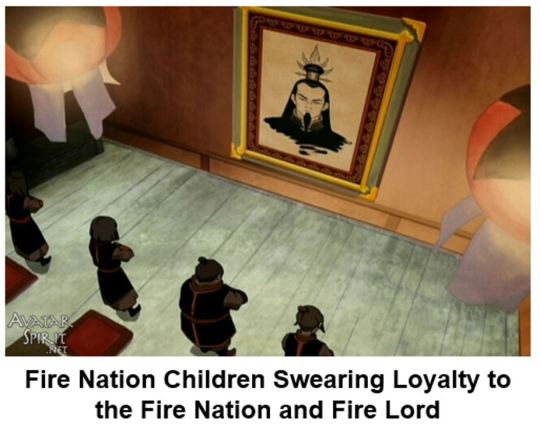
After hundreds of years of peace and an unprecedented era of prosperity, the Fire Nation began to lose its internal enemies. The lords and nobility were under full control. The Imperial Government was vast and efficient. Nobody was trying to invade the Fire Nation. Everyone was happy and proud of their culture and government.
This allowed Sozin to begin looking outward. Using the all-powerful Imperial Government apparatus developed over the centuries, plus the sweeping loyalty to it ingrained into the public, he was able to get the country to go to war against the world. The militarism inherent to the Fire Nation’s leadership was not crafted out of whole cloth but simply cranked up and sent down a dark path.
The military being so willing to go along with it was because of their inherent loyalty to the Imperial Government and their culture of aggression and lust for battle necessary for warriors. This is actually where the 20th century Imperial Japan connections come in, but that’s a separate topic.
In summary, the Fire Lord and Royal Family view themselves as stewards of the peace and order of the Fire Nation. They see their responsibility as doing whatever it takes to prevent the “bad old days” from returning and that the Fire Nation is never weakened by foreign invaders. They rule through coercion and fear in order to ensure a country full of people who can shoot fire out of their hands remain subservient to the Imperial Government’s will. They embrace a culture of fighting because their primary goal is to prevent fighting by deterring those who might want to try.
An Alternate View of the Fire Nation’s Villains
Viewing the Fire Nation’s culture, government and leadership through the lens of Japanese history paints a more coherent picture of the Fire Nation’s villains, versus the M.C. Escher-like theories that result from focusing entirely on mental illness and personality disorders.
Look at it like this: the Fire Lord demands fealty and obedience from the people yet Azula’s emphasis on controlling people through fear is a result of Freudian Excuses and personality disorders?
No way.
Ruling through fear and coercion is necessary from the viewpoint of a soldier-princess who is supposed to command obedience from subjects, or else.
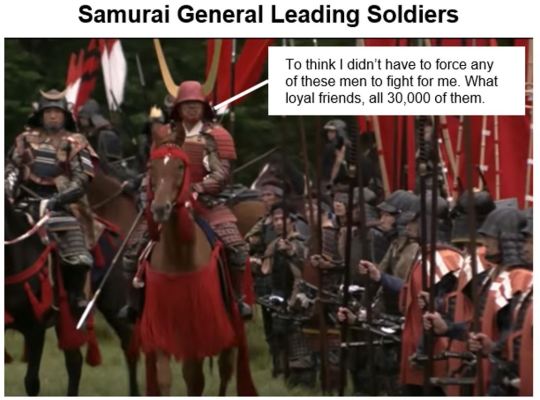
Agni Kais are expected events in Fire Nation culture, so common that child-Zuko is perfectly happy to face the general over mere “disrespect”, but the Fire Lord challenging his son to one is uniquely out of line? It’s awful, I mean, really awful, but it’s not out of line and it says a lot about the ingrained culture of the Fire Nation; Ozai didn’t think it would be viewed as shameful by everyone watching. Keep in mind that the tale of the 47 Ronin started with one member of the nobility insulting the other (essentially) and being asked to commit suicide simply for drawing a weapon inside Edo Castle (strictly forbidden). If Ozai can have his power challenged as any other Fire Lord can, then nobody was willing to oppose him because everyone else supported him.
Iroh spends a lifetime invading the Earth Kingdom, no doubt killing tens of thousands, and he can joke about burning Ba Sing Se to the ground? Of course he can, because it’s what Fire Nation generals do and part of the terrible culture that must be changed, as horrible as it was. The prince-general is supposed to be a military leader and enjoy what he does. He better not be squeamish.
Zuko is expected to be “loved and adored” for having firebending talent, courtly manners (to quote official descriptions of Azula) and intelligence in a similar fashion as his prodigal, early-blooming sister? Yes, because she bloomed early as the type of princess the nobility and leadership want and expect. It’s unfortunate they were so hard on Zuko, but now we know why he wasn’t “adored” like his sister; she was what others wanted Zuko to be.
Ty Lee is strong-armed by Azula into leaving the life she loves, even having her life threatened, when Ty Lee is a family member of the nobility that the Imperial Government seeks to control? Of course she is strong-armed. Can you really imagine this scenario playing out:
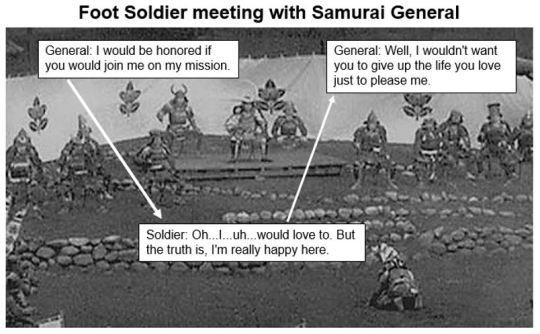
Those lines are taken from the show. Sounds a lot different, doesn’t it? Ignore the smirking and smugness for a moment and think about what is actually happening: a supreme military leader and heir to the throne is bullying a subordinate in order to get what they are entitled to; unwavering loyalty from a subject. Doesn’t make it good. Doesn’t make Ty Lee’s fear and loathing of Azula any less justified, but it puts it in a much more relevant context than vague theories of sadism and personality disorders. It also tells us something about the real ancient world: this how military rulers in East Asia’s history behaved and now you’re getting to see it in a fictional setting.
Fire Lord Azulon orders one of his sons to execute their son? That’s bad. Really bad. Did you also know that Ieyasu Tokugawa ordered his own son to commit suicide over suspicion he was conspiring against him? He didn’t want to but those were the wishes of the lord he was working with to win the war. That’s really bad too, and not shocking for the era, unfortunately. The leaders of the ancient world valued human life a lot less than people do now. It’s sad they didn’t value it more.
Manipulating subordinates (i.e. playing them off each other) and being ruthless were not frowned upon, but legitimate tactics. Murder and backstabbing were useful means of getting rid of an opposing leader. What mattered was winning, and the blood on your hands could simply be washed off, and if people didn’t like you for it? Well, were they in charge?
None of this is “good”. None of this is moral, or righteous, or anything close to how people should act in the modern era. However, these were not kleptocratic dictators like we see around the world today. These were legitimate administrative rulers by their day’s standards, and we (you and me) will never truly know what they were feeling when they woke up in the morning with the responsibilities of warfare and politicking.
We will never be able to completely relate to what these ancient leaders did. Do you know what it’s like to be the law in the land who can order people to commit suicide, and who will do it? Do you know what it’s like to prosecute a political and military war against multiple opponents across a vast country? Do you know what it’s like to manage an ancient authoritarian government after hundreds of years of warfare and chaos? None of us will, but that’s the kind of situation that a fictional country like the Fire Nation can take inspiration from, and should take inspiration from.
These were all very real problems of the ancient world and problems which Avatar, as a fictional work, can allow us to explore in the safety and comfort of not actually having to be there (and without having to open up huge history books).
Summary
The Fire Nation’s political and military history can be modeled on ancient Japan’s, in particular the rise of the Tokugawa Shogunate, where the Fire Lord represents the shogun and the Fire Sages the emperor.
The Fire Nation capital is both the head of the administration and home to the nobility’s families, who are held as hostages (in comfort) to prevent the various lords from rebelling.
The Royal Family and Imperial Government rules through fear and threats of force because they have to keep a country full of walking flamethrowers in line.
As military leaders who can have their power challenged, firebending talent and military prowess are highly valued and necessary for Fire Lords. At the same time, the rest of the country’s leadership wants leaders who appear worthy of that power and authority, hence those who have all the right qualities (Azula) are viewed in higher regard than those who have less (Zuko).
Azula’s emphasis on using “fear to control people” is not a psychological hang-up but a natural tactic of the Fire Lord, military, and Imperial Government to maintain obedience; as a teenager with limited life experience, she has internalized her role as a princess and warrior to the detriment of her personal relationships and emotional maturity (this is where the “child soldier” narrative has relevance).
Ozai represents the pinnacle of self-interest, authoritarianism and militarism that the combination of Sozin’s War and the longstanding nature of the Imperial Government have combined to create. In the ancient world, lords waged warfare for two reasons: to acquire power or pre-emptively wipe out rivals. Ozai wants power.
Ozai challenging Zuko to an Agni Kai is awful but not unusual, hence why he felt he could do it at all. Agni Kais are a fundamental aspect of conflict resolution in the Fire Nation, most likely because the Fire Nation’s leadership values bravery and a willingness to fight very highly. As Zuko was a prince and future leader of the warrior class, those values applied to him as well, but they got applied to him far too young (again, this is where the “child soldier” narrative has relevance).
And finally, by modeling the motivations of the Fire Nation’s villains and heroes on the military leaders of ancient Japan, you have the opportunity to learn about and critique that ancient society while also giving it a fictional flare.
As a final remark on applying the history of ancient Japan to the Fire Nation, the Tokugawa Shogunate ended when the Emperor forcibly took control of the Tokugawa government in order to end the forced isolationism. If ancient Japan hadn’t been pressured to adapt to more advanced European civilizations (say, if it existed in a vacuum) then the Tokugawa Shogunate might have continued to be the longest and most stable period in Japanese history; post-World War 2 Japan is only 70 years old while the Tokugawa Shogunate lasted for 278. When the Emperor wrested control of the country from the Shogunate, there was already enough peace, stability and government bureaucracy in place to lead a rapid transition of the country into modernity. That was the ultimate value of the Tokugawa Shogunate.
If the Fire Islands had not unified under a central authority, then they might have never industrialized so rapidly during that “unprecedented time of peace and prosperity” and may have eventually been conquered by the Earth Kingdom (should an EK conqueror have found a way of killing the Avatar, or taking advantage of their absence).
Conclusion
Think about ancient Japan for a moment. All of the warring lords. The conquest and ruthless political maneuvering. The ruling through fear and totalitarian control. What is a more reasonable explanation for the behavior of that society: mental illness and personality disorders, or universal concepts of ancient nation-building?
What makes more sense for furthering Avatar’s East Asian themes in terms of the Fire Nation: sociopathy, personality disorders, lack of fundamental human qualities, petty bullies and insecure abusers? Or universal concepts of ancient nation-building in the context of people who can shoot fire out of their hands?
Was Ieyasu Tokugawa suffering from a personality disorder? Was ancient Japan swimming with people who lacked fundamental human traits? That would be and absolutely extraordinary anomaly of human genetic variation.
When discussing the evils of the Fire Nation, you have to start with the in-world context that created them, and in order to understand that context, you have to apply some East Asian history. Why “decent” or “normal” people end up doing terrible things is a question as old as humanity itself and should not be erased from Avatar.
In order to understand why Ozai and Azula seem like “bad” people to us, it’s because the rulers of ancient Japan acted like bad people. Zuko can’t be soft and fumbling. Azula can’t let people say no to her. Iroh can’t abandon the siege with no consequences. Ozai can’t let Zuko refuse to fight. As bad as many of these things are, they are driven by the fact these people are the most powerful entities in their country and must show their fire-wielding subordinates that they deserve their power and should not be challenged. There is no room for weakness, only strength and competence.
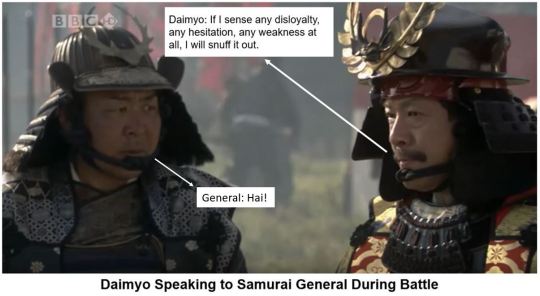
When you resort to psychological theories or genetic anomalies to explain the Fire Nation’s villains, you erase the opportunities to tie the Fire Nation to critical elements of East Asian history, namely the rise and success of the Tokugawa Shogunate. By relating the main villains of Avatar to the very real “villains” of the ancient world, you preserve the East Asian themes that make Avatar unique and informative to a Western audience and help shed light on what drove them to be what they were.
1K notes
·
View notes
Text
Making Waves by Sophie Lovett
Mothers Who Make’s is hosting a series of guest bloggers, to celebrate and give space for the diverse views and voices within our movement. I am delighted to introduce our first of these: please read on for the Question of the Month, as posed by home-educating mother of two, writer and activist, and MWM Hub co-ordinator for Exeter, Sophie Lovett.
Before you read this post I feel that I should apologise: in case you disagree with me, in case what I’ve written is too much, in case it offends you. But this is Mothers Who Make, and we don’t apologise here for showing up as our whole selves, so instead I will take a deep breath and begin.
This has been a tough year. A tough year after a tough decade. One which, on a personal level, has been filled with many moments of joy – but where the weight of the world has pressed ever harder on my shoulders.
We’ve never lived through a pandemic before.
It’s brought out the best in us, and the worst. It’s brought us closer together, and deepened the divisions in values and circumstance that are tearing our society apart. And it has made the priorities of our government - to put profits above people – very, very clear.
This neoliberal agenda has its roots way back in the 20th century, and over the years we have pretty much come to take it for granted. Notions of unrestrained economic growth, wealth which is available to everyone if they just work hard enough, and the promise of freedom which is earnt by playing by the rules of society - alongside a reality of gaping gaps between rich and poor both on a domestic and international level. In many ways the Coronavirus pandemic has provided precisely the kind of crisis that the neoliberal elite love: an overwhelming distraction that they can use to impose more unpopular policies, accusing people of being unpatriotic or even undemocratic if they oppose them.
Yet it has also sowed the seeds of something new. Off the back of years of campaigning from environmental and social justice organisations, many more people are beginning to realise that the future could perhaps look very different. That the planet cannot handle this unfettered capitalism for much longer – and neither, given the explosion in mental health issues even before the challenges inflicted by 2020, can we. That there might be different ways of living that could be more fulfilling for us and our children, whilst at the same time starting to reverse the destruction we have wreaked on the global ecosystem.
And this – this imagining of a different world – is making some people very uncomfortable.
In England, the government released guidance last week which told teachers not to use resources from any organisation which has advocated abolishing capitalism – even if the materials themselves did not express such a view – as it would imply support for an “extreme political stance” on a par with racism and opposition to freedom of speech. Aside from the obvious hypocrisy of a statement which alienates many anti-racism campaigners and seeks to silence the voices of those who might want to legitimately challenge the status quo, this is a sign to me that they know their power is waning. The neoliberal story is coming apart at the seams, and a new narrative is taking shape which could take things in a very different direction.
As actors in that narrative we have a choice to make about the future that we want to see. And as mothers – and especially as mother makers – we hold in our hands a huge amount of power to shape the world our children will grow up into.
It might not always feel that way.
One of the most effective strategies of neoliberal capitalism is to convince us that we are not enough. That we are deficient in a myriad of different ways, and powerless to take control. It makes us the perfect consumers – hungry for the things we can buy to improve ourselves and make life better for us and our families. And if we can’t buy them – if we are part of the huge swathe of the population struggling to even afford the basics we need to live – we are taught that it is our fault, that we’re just not trying hard enough.
In motherhood especially this can lead to a real sense of disempowerment – a lack of trust in ourselves and our ability to provide for our children. There is so much that is marketed to that desire to give our children the very best start in life: elaborate toys, sleep training programmes, gorgeous clothes, endless baby classes. It plays into the competitiveness which fuels the capitalist fire, the fear of being left behind. It sells us baby walkers (and mini trainers) to get those little people up on their feet as soon as we can, electronic learning games for toddlers in the hope that they’ll know their ABCs before they start preschool, tutors to help seven year olds pass their SATs with flying colours. It rushes us back into the workplace before we’re really ready, no matter that our salary barely pays the childcare fees. It tells us that teachers know our children better than we do, that school is the only place they can get an education, and that compliance with authority is the most important lesson they can learn.
None of this is bad in and of itself – if it works for you then that’s awesome. But if it doesn’t, if the treadmill is making you tired and you’re fed up of searching for the next best thing then stop. Breathe. And work out what it is you truly need.
Our role as mothers may be woefully undervalued by the capitalist system, but we do have the power to choose where we focus our energies, to withdraw our consent from expectations that we disagree with, to challenge the assumptions around the status of mothers (and children) in wider society.
We can choose to raise our children with principles we believe in, to communicate messages to them that deviate from those which dominate the mainstream, to be their allies and their advocates instead of colluding in their oppression.
And, little by little, we can build a kinder, more inclusive world – one where everyone has value.
If as mothers we hold the future of the planet in each act of care we carry out for our children, as mother makers we are doubly powerful in our ability to reach beyond our inner circle and inspire through the particular capacity of art of all kinds to reshape the narrative and reimagine what is possible.
Creatives are uniquely placed to lead the revolution – and this is I believe a significant reason why the UK government shows such disdain and disregard for the arts and creative industries.
Just as Media Studies is decried as a ‘mickey mouse’ subject because it directly exposes the techniques the government and their allies use to manipulate the opinions of the population, the Arts in schools are sidelined because they nurture exactly the kind of creativity and independent thought that can be used to challenge the status quo.
It starts in the Early Years, when days that should be dedicated to open ended play are instead filled up with increasingly formal literacy and numeracy, and can be seen right through the education system: ten year olds spending whole terms doing nothing but exam preparation, teenagers being told they can’t study the creative subjects they’d prefer because they don’t fill the right assessment bucket. And it continues in the world outside, as the government response to the impact of Covid has shown so starkly.
Our art is important. Our making is important. It holds a mirror up to the present and shows how life could be, it inspires, it sustains – and it can be an escape route from the treadmill our leaders would rather keep us tethered to.
From the stories we tell to the songs we sing to the materials we choose to the business models we adopt to share our work: we are creating the fabric of the future.
And so this month, wherever you are in your mothering and your making, I would invite you to consider these questions: What are the changes you would like to see in the world? How are you making waves in your mothering? And in your making? What changes (small or large) could you make in either to help create the future you dream of for yourself and for your children?
To read more from Sophie go to: www.raisingrevolutionaries.co.uk and https://www.instagram.com/raising_revolutionaries/
2 notes
·
View notes
Text
ok, i’ve been telling my dad this for months and i thought i’d finally share here. here is my dream scenario for when shadowhunters comes back (since i still keep hope that it will). and by that i mean what should happen- within realistic parameters- that i think would bring the show more general positive reactions, a larger fanbase, and stable success to ensure many more wonderful seasons. so we pick up shortly after where the epilogue left off- with the mains divided into the new york group and the alicante group- and they stay split up. this allows for 2 “A” storylines to run concurrently to allow for a wider audience to stay invested and more character dynamics to be fully explored, instead of shoved into rushed, very limited screentime “B” and “C” storylines. i’m thinking similar to daenerys and jon snow (pre s7) in GOT, aka equally important main leads.
clary remains the hub of the NY squad, as she’s always been. she is the favored female of the fandom, and this still honors the spirit of the books. alec becomes the hub of the alicante squad. he is the favored male of the fandom (tv time’s recent poll had him at more votes than the next 2 guys combined. he had over 700,000 while jace and magnus only had over 300,000 apiece. clary was at over 200,000). ok, we’ve got the chosen by logic “hubs” so let’s talk the “spokes”.
NY squad includes jace, obviously, and simon, izzy, maia. but instead of sizzy or saia, they slowly develop into a polyamorous throuple. this accomplishes many things: 1st, the shippers could make peace. 2nd, maia would have a solid link to who’s always been the center of SH: the lightwoods family. and 3rd, it could trim the fat, so to speak. instead of having supporting character wlw (heline, ollie, sam- all stereotypically characterized tv wlw, who only ate up screentime that should’ve gone to the downworlder mains imo) the wlw rep could be izzy and maia- already fleshed out mains. after spending time together resulting in unlocking some feelings, they could all get together since they both still care for simon too. now they’d have to be bi/ pan obviously- so no lesbian rep- but as a lesbian myself, i’m averse to the idea that every show has to “check every box”. quality over quantity. a trio of only POC is original vs just another wlw pair with 1 white person. as long as it was written properly, it could avoid bi stereotypes.
now the NY squad has all the different dynamic options to explore that this fandom seems to love (clace, climon, clizzy, claia, sizzy, saia, jimon, and jaia. and the jace/ izzy dynamic can finally get it’s dues!) and with a 3 POC to 2 white ratio, it’s better diversity than when things always revolved around the squad of shadowhunters in s1 thru s3. meliorn can join the fun sometimes. clary gets her powers back, but hopefully without the “mary sue” aspect. when the solution for everything was often just being shown new runes and drawing them, where was the earned achievement? (versus like when valentine was defeated, she did that!) generally, self-made heroes- rather than “born special”- are more relatable and inspirational. like arya vs daenerys- who was born able to hatch dragons in fire. she achieved so much, but without the dragons- like clary’s angel powers- none of it would’ve been possible. then again, i know daenerys is very popular, so my preference in hero types obviously isn’t universal. so either way, i guess.
on to the alicante squad (my personal favs)! magnus and luke have obviously already joined alec here, and they’re rebuilding the shadowhunter homebase to be an accepting environment. there has to be an actual lengthy, difficult power struggle here- an extremely prejudiced regime like the clave wouldn’t just topple overnight. maryse is here too and should be bumped up to be a main. then it’d be 4 women to 5 men as our mains- much more balanced. then 1 or 2 new lady characters could be introduced. let’s get some new blood on the show! and to appropriately fit into the already existing dynamic here, it’d be best if they were 30+ in age. (and hopefully they cast taller ladies, cuz aside from the mother roles- jocelyn and maryse- all of them have been 5′2″ to 5′5″ and it’s time to mix it up). they can develop solid friendships with our squad. also the parabatri needs to finally get it’s dues, since we’ve been robbed long enough. ok, and so with 1 shadowhunter, 1 downworlder, 1 sh turned dw turned sh again, and 1 sh turned mundane, there’s a lot of different perspectives here. and the new ladies could have their own unique perspectives as well. so it’d be very interesting for there to be problems they all must solve, but they each have their own ideas on how to go about it. thru compromise at times- and deferring to the one who’s perspective lends a better insight other times- they’d have innovative solutions.
to address why mizzy instead of either with clary, why the new women would probably not be wlw, and why the “hubs” are both white- it’s cuz the point of this post is me throwing in my 2 cents on what changes could be made- in the hands of new showrunners and now that we’re free of the book material- but is still possible, realistic, and viable given the way the industry machine works, and the demographic of this fandom. i’d also like to note that i just really want raphael and catarina gone, since they refuse to let magnus interact with them! they each only had 4 eps with him, yet they’re his “family”? it became beyond absurd! raphael= none in s1. 1 in s3. catarina= none in s1/ s2. only 1 in 3b- 3x22 doesn’t count cuz they didn’t talk at all. and for those who’d balk at alec being separated from jace and izzy, i say- have you never met adult siblings? it’s healthy, normal, and encouraged in society, that when siblings grow up, they go their own separate ways and live independent lives. forge their own paths. it does not mean they love their siblings any less. i have a sister, i should know.
in conclusion, the 2 separate squads would have their own adventures in the first 8 episodes of each half season. i think most everyone agrees that politically driven themes- dealt with symbolically thru this fantasy world- would make for better story arcs rather than just good vs evil (val, jonathan, lilith) all the time (esp since SH doesn’t have the budget to make fantasy elements very exciting). since there is a nice ratio of shadowhunters and downworlders in each squad, the set up for these themes would already be in place. and then much like any show that has divided storylines, at some point you’ve got to bring them all together. this could happen in the 9th episode. a wedding or holiday celebration or whatever. they could all sit around a giant table and have a feast and this ep could just be warm and fuzzy. lightwood family time- including magnus/ jace’s long overdue friendship- and a chance for them all to reconnect, until the last scene of the ep when some big bad guy dramatic problem could arise. then the final ep of the half season could be them all working together (as a whole or separately in smaller groups) to defeat the big bad (save the budget and the big fantastical sets/ creatures for the finales). end on an exciting cliffhanger. ta da!
#shadowhuntersedit#tagged to reach a larger audience#plz no one start drama#just sharing my thoughts#if you like it let me know :)#if not... oh well#meta#like i said this isn't my absolute ideal scenario either#seeing as alec/ izzy is#my 2nd fav dynamic on SH after malec#but overall i feel this would be best#ok i've reread and edited this post#like a billion times for over a week now#i'm not even kidding#so time to just post it already#here we go...
7 notes
·
View notes
Text
Sol, The Ardent Apprentice
A short story by: Ominous_The_Unknown
I
In the magical world of Runeterra, mountains move, forests come alive, the dead assault the living, and reality sometimes fractures to give a brief glimpse to the horrible Void beyond. But even though the arcane energies course through all the nations, there is no other place quite as whimsical like Bandle City, the central hub of Yordle life. Across the lands, these short creatures are seen in a multitude of different perspectives. Forest fae-folk, mischievous imps, urban legends, valiant warriors, and heinous villains, Yordles always seem to be synonymous with some kind of outstanding trait that makes them outstanding in their own right.
During their early, formative years, young Yordles quickly come to find what makes them unique from one another and once they do, they soon set themselves down the path to honing their skills to try and become the best in their craft. Of course, not every Yordle specialized in entirely different things. It was common for some to be gifted a knack for tinkering and invention much like the great minds of Heimerdinger, Rumble or Ziggs. Others were given more physical, combative skills like Tristana or Teemo. And of course, there was the occasional magic user like Lulu. But what happens when your talent doesn’t manifest when it should? What happens when the people around you develop some kind of magnificent skill when you are left with nothing?
Sol was forced to ask himself this question many times over when he realized that the other young Yordles around him were attaining their unique abilities whereas he had none. In the beginning, he was assured that he would find his niche soon enough, but time passed and he still found himself left in the dust. He would watch as others were able to conjure small balls of energy, create phantasmal elemental displays, briefly summon ethereal aurora-like creatures, or even infuse machines to give them extra vigor. It wasn’t long before the older Yordles decided to properly study him. A few of the more astute researchers of the city came together and performed a few tests on him, hoping to find the answer.
Then, to Sol’s horror, he was finally given the bad news.
Unlike the others, the charcoal gray yordle was magically inept and lacked a mana pool to draw the necessary arcane energies do anything noteworthy. At that very moment, it was as if the weight of Mount Targon was set upon the Yordle’s heart. The information was a curse that forced Sol to watch helplessly as his close friends became apprentices to some of Bandle City’s champions while he was subjected to a mundane and unfulfilling life. Even at a young age, Sol felt that his dreams of becoming some well known Yordle had been destroyed. He grappled with the idea for a while and in the end, he outright refused to accept it.
Bitterness and envy slowly slithered into the young Yordle’s heart, poisoning him ever so slightly, but instead of letting it destroy him, Sol used it to push onwards. Soon it became apparent that what Sol lacked in magical prowess, he made up for in tenacity, boldness, and creativity. Bullies would, of course, try to take advantage of him or tease him as they flaunted their skills in front of him. The name-calling, the minor physical altercations, the laughter, it stung, but Sol relied on the fact that they underestimated him so that he could beat them at their own games.
If anything, his newfound strength despite his lack of mana actually made him stand out more because he would do everything in his power to ensure that no one looked down on him. He refused to sulk, he refused pity, and above all else, he sought to break the fate that had been cruelly handed to him. Within the Yordle, a sort of bullheaded attitude emerged as he sought to absorb as much information as possible to see if anything triggered some latent talent hidden within. Archery, crafting, smithing, politics, Sol would attempt to learn everything. Even when he didn’t become a master at it, he at least came away with some experience. Ultimately, this meant that Sol became known as a jack-of-all-trades.
But once Sol became an adolescent, he realized that his accumulated skills still weren’t enough. Instead of continuing to study within the small confines of Bandle City. the abnormal Yordle made the decision to explore the world. Many people within the city knew that it was possible and that even some of the more famous Yordles had survived to become rather huge stars in other cities, but it was still a risky decision. The elders of the city said he was a fool and that without forging his own unique talent that he would quickly die without any ability to protect himself, but Sol’s close friends knew that because of his myriad of skills that he would forge his own path.
The young Yordle quickly assembled enough equipment and other necessities and bid a fond farewell to Bandle City and its inhabitants before he journeyed outwards. He would find new mentors, make new friends and discover what was truly hidden deep within him.
---------------------------------------------
II
There were many limitations to being a Yordle. In some places they were seen as normal living beings with rights, others they were a myth and in a select few they were abhorred and either cast out like plague bearers or maybe even attacked on sight. With that in mind, there were unwritten rules for traveling abroad as a Yordle.
The first and probably most important rule is to never reveal oneself as a Yordle. Information travels slowly through Runeterra, and even though some progressive regions accepted all races that was not the case for the majority of the world. To socialize, most traveling Yordles were often given a magical glamour that would simply disguise them as short humans. There were some fringe cases of course, like the valiant Poppy, deranged Kled and estranged Lulu, but that was mostly because they were more than capable of defending themselves if they were ever threatened with violence. For other Yordles, physical altercations were best avoided.
Even with a rather large list of practical skills, without magical energy Sol’s friends and family knew that it would be best if he traveled prepared. Before departing, Sol was gifted an enchanted pendant that could accomplish such a task, but he soon discovered that his mana deficiency would cause issues. The glamour itself very slowly used up the wearer’s mana when being used, and in most cases, a regular Yordle could wear it for as long as they wanted since they would regenerate the energy just as fast as it was being depleted. So in Sol’s case, he could only activate the pendant for a few days before his body ran out of mana to power it, then he would have to travel as his regular fuzzy, self to recharge. There were many instances where that proved to be a huge disadvantage, but during his adventure, he just learned ways to work around it.
Along with the stigma against his species, Sol also began to interact with various living creatures in the world. Some were warm and kind, others brave warriors filled with courage and honor, while a select few had bitterness and anger brewing within them. The growing Yordle had to observe and catalog every interaction as he started to develop his own set of rules to operate by when he revisited certain locations. His tome of rules slowly grew over time and he would openly share them with fellow Yordles that he happened to come across during his travels, for example:
Never challenge a Noxian. Their hardy nature makes them competitive and their bloodthirsty traits mean it won’t take much until they lose their temper and draw a weapon.
If a Bilgewater pirate questions if you’re a Yordle, tell them you’re just small hairy and that they’re too drunk to tell. Also, always keep a few golden krakens with you whether you believe in their superstition or not, it may just save your life.
No matter how furry you are, always wear warm layers when traveling in Freljord and try to stay dry. Wet fur can turn into solid chunks of ice if you’re not careful.
STAY AWAY FROM THE SHADOW ISLES AT ALL COSTS
When in Piltover or Zaun, try to wear a magical glamour or at the very least wear a disguise. Both places demonize Yordles and have even imprisoned them.
Piltover is nice, but there are many flashy hypocrites there who don’t know what they’re doing. However, you can always go to Heimerdinger at his laboratory for a safe haven since he’s a well-known researcher there.
Zaun is dangerous for a litany of reasons, like roving madmen, and a bloodthirsty chimera wolf-thing and just rampant lawlessness. Also, be careful of friendly fire when traveling in Zaun, Ziggs is known to go crazy there from time to time.
Sol’s notebook was starting to become an epic in its own right as it documented his travels day by day, carried numerous errata and inserted trinkets and drawings. His accumulated skills also made him a rather valuable asset in most situations as he was able to make himself useful in dire situations. Despite his short stature, Sol was able to repair a ship’s sail during a storm, cook meals for the less fortunate, and even help build makeshift shelters. Even though he wasn’t exactly perfect at the job, the mere fact that he would always volunteer to help and put himself out on the field made him very likable.
He found himself partaking in many different adventures as he followed his heart and traveled all around the world. Sol had spent some time helping on a fishing boat, infiltrating bandit camps to save captured Yordles or even cavorting in ancient ruins to find treasure or long lost secrets. If anything, the exploration of it all appealed to him the most and he loved to dig deep into the history of long dead people and inspect the artifacts that they left behind. When he sometimes came into contact with ancient relics, they would flicker or light up as the energies bound within them were somehow stirred to life, but strangely enough, when he handed those very same items to his compatriots, the object would go silent. Sol would also discover old scrolls or books written in dead languages, but just after studying the strange iconography and hieroglyphs, he seemed to understand what they meant and in some cases could even pronounce them. Sol just attributed this to his litany of skills that he had built up though and didn’t think much of it. He never bothered to inspect the magical items further, since he knew that his minuscule amount of mana would never unlock the secrets within them.
During one period, Sol had discovered a faded map of some ancient civilization in a nearby forest. He spent a week studying the language printed on it by reviewing what information he had and he deduced that there must be some kind of treasure hidden within. Sol gathered his belongings and started to move headstrong into the brush before he finally came upon his destination in a matter of two days. Using his uncanny ability to read the hieroglyphs and understand the ornate designs of the art on the walls, the charcoal black Yordle was able to avoid or even disarm most of the traps laid within the ruins before he finally discovered a hidden room with old leather-bound tome displayed on a plinth.
Even though Sol was unsure of the book’s origin, he could at least surmise that it was important and the instant he set his hands on it, multicolored energy cascaded out of it in an aurora-like tornado. The book opened as light poured out of its pages and wisps of power trailed out into the world beyond. As the pages rapidly flipped in front of him, the Yordle looked on with confused awe as he realized that he was somehow barely reading the words as they flew past him. His lips began to move on their own as the energy within the pages abated and appeared to listen. But even then it was still too much.
Sol had no idea how it was possible, but he could feel the energy pulsing through his veins before it started to become a searing hot pain that radiated through his arms and into his chest. The dark gray Yordle found himself unable to let go of the book, which brought a fresh wave of panic over him. He could feel his very life essence getting immolated from within as the foreign energies burnt to brightly inside of him.
As he was about to pass out from the pain born of the immense power another aura entered the room. For a brief moment, a dark purple and green energy appeared before a bolt of arcane power shot out of the darkness and collided with the book in his hands. The force of the blast was enough to blast the book out of Sol’s hands before it spiraled away as a burning heap. Sol crumpled to the ground, chest heaving and his vision blurring as he barely registered a figure approaching him.
Clad in dark purple garb with a large wizard’s cap atop his midnight black fur, the infamous Yordle Veigar came forward and looked down at the fallen adventurer. Before Sol could speak though, the world around him faded to black as he slipped into unconsciousness.
----------------------
III
By the time Sol woke up, he found himself in a candle-lit abode somewhere within some kind of intricate cave system. His body ached but he was at least thankful he could still move. He lay atop a creaky old bed, with some decrepit bookcases and drawers to act as furniture. Everything seemed to be secondhand, scavenged and mismatched, and yet whoever assembled everything at least took the time to clean the dust away somewhat. He could remember an infinite well of power being poured into his body. So much power that it was actually agonizing.
Without any introduction, Veigar began to berate Sol for how foolish he was being. The dark master of evil wasted no time in explaining how the tome was cleverly hidden trap meant to entice any curious magic user into coming into contact with it all for the sake of burning them from the inside out. He then expounded that if it wasn’t for him, Sol would’ve been turned into a pile of ashes on the ruin floor.
The only reason why Veigar had decided to intervene was that he noticed something strange about the trap that Sol had sprung. He explained that the book worked by manipulating a person’s innate mana pool to disrupt the inner balance within it. What he found interesting was that Sol didn’t explode as he thought he would and instead somehow started to read the text even though it was a long-dead language. Veigar then immediately began to question Sol’s identity and how he was able to not only read but speak the dead tongue but to his surprise, the dark gray Yordle could offer no solid answer.
“I just have a knack for it I guess.” Was Sol’s answer as he gave a nervous chuckle.
His answer only made Veigar raise an eyebrow skeptically before he let out an irritated sigh and reached into his coat. He then withdrew what looked like an old bone with odd letters scryed into it before he tossed it carelessly at Sol. The injured Yordle yelped as he just barely managed to catch it but the instant he saw the letters the gears began to turn in his head. It was another dialect vastly different from the ones he had seen in the book previously and yet there was some odd feeling of familiarity to them. Before Sol could ask what it was, Veigar also took out his short staff and began to focus malicious power into it. The Tiny Master of Evil then pointed the empowered end of the staff at Sol’s face before he demanded that he read the letters.
Panic immediately consumed Sol as his eyes widened and he assured Veigar that he just had a faint clue as to what the letters meant, but he could already see that the pitch black Yordle did not believe him. Sol could feel his heart beating rapidly in his chest as the heat from Veigar’s magic staff brushed against his fur. He knew that reasoning wouldn’t work, so Sol looked down at the ancient bone and did his best to try and divine the meaning behind the letters.
To his surprise, everything began to click for the charcoal gray Yordle as it seemed like the ancient inscriptions somehow morphed into the words and letters that he was familiar with. Unsure as to how it was possible, Sol didn’t care and simply began to recite the words on the bone, hoping that it would appease his captive. The more Sol spoke, the candles in the room began to burn brighter before they shifted into a lavender hue. He continued to read the words before Veigar finally snatched it out of his hands and snickered.
Scared and confused, Sol asked the mage what just happened as Veigar just smirked at him. He was able to somehow divine the meaning behind dead languages before, but what he had done was on an entirely different level. Veigar then explained that somehow, someway, Sol’s innate trait was the ability to read and tap into the magic trapped within ancient artifacts. His lack of a large mana pool actually made him the perfect conduit for oddities and enchanted items to flow and mesh with him.
To further prove his point, the pitch black Yordle went over to one of the nearby shelves and carelessly pulled out of the book before he threw it at Sol. He explained that many of the books that he had procured over the years were magical in nature and most were inscribed in foreign languages both living and dead. Sol gingerly opened the book up to a random page and to his surprise, he could understand the words in there as well. Next, Veigar took what looked like an orb of polished onyx and handed it to Sol. From what the mage knew, information within the book could unlock the true potential of the artifact and he asked that Sol read a passage to see if anything happened.
Nervous, but now somehow energized at realizing his dormant talent, Sol carefully read the text before he slowly began to say the words. As he did, the orb began to vibrate and emit a low hum until it started to float.
Giddy smiles spread across both Sol and Veigar’s face at the sight of the activated artifact before the black furred Yordle crossed his arms. He then gave Sol the opportunity of a lifetime by asking if he wanted to become his apprentice and help unlock and master the magic-infused within all of the items that he discovered. Feeling that he already owed the mage a debt for saving his life, Sol gladly accepted the offer and soon his real work began.
Once he was fully healed, Sol would spend hours pouring over books, scrolls, and engraved tablets while at the same time handling and coaxing the magic out of ancient artifacts and weapons. To both his and Veigar’s surprise, he was able to unlock their true potential fairly easily as the dead languages flowed from his mouth and further accelerated his learning. Sol’s arsenal of artifacts soon grew over the years as he and Veigar traveled around, collecting items and deciphering old script as the charcoal gray Yordle was perfectly content with being a lexicon of antiquated knowledge.
7 notes
·
View notes
Photo
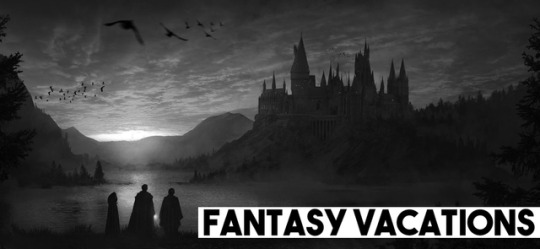
Fantasy Vacations
I took some time to think about the fictional places I love to visit; either to go to school, drink, dance, party, read books, swing a sword or simply just explore the local culture. Below you will find 47 of the best must-visit fictional locations (according to me) and some reasons why I would love to go there. Don’t take this to serious it's all written for shits and giggles. Let me know if I made any mistakes or if you have any late additions and thanks for reading.
Regards, Michael California
Alpha The City of a Thousand Planets

Valerian and the City of a Thousand Planets did not do well in the theaters, to say the least, it was poor casting choices that sunk it. However, the opening of the movie with ‘Alpha’ growing in mass starting off as the original International Space Station and adding alien visitors over time before becoming a massive city in space was a pretty cool concept and scene to watch to the music of David Bowie. With 3,236 unique species on board, there is a real chance you could live there your whole life and still not meet every kind of alien life form. Who wouldn't want to live in a hub of alien cross-cultural?
Arrakis

The “Spice Must Flow” and “Fear Is The Mind Killer”. Arrakis and the book Dune, which is celebrated in Scifi much the same way Tolkien is celebrated in Fantasy, is a sand world with giant worms, a scarcity in water and a world in the center of political conflict all in the name of Spice, a mind/body-altering drug that extends life and allows space travel. Arakis is hardly a place you would want to go on holiday but you go to a place like this for cultural depth of the Fremen people and if you’re lucky, ride on the back of a Sandworm. Which frankly is good enough for me. Please note consumption of spice may turn your eyes blue.
Asgard
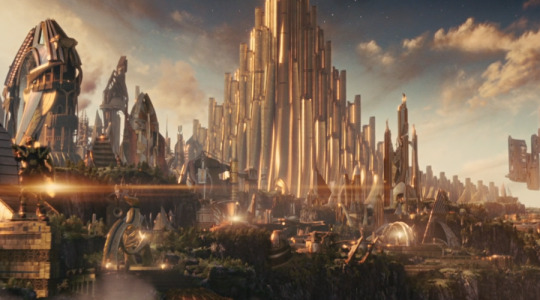
A city of gold floating in the heavens and home to literal gods? Asgard has a lot to offer in the way Norse Culture and would be my kind of place to visit. It’s one of a few vacation spots on this list that might be considered a utopia even if you're under a Mythical Monarchy; a balance between a combat culture, art, music, literature, rowdy partying and it also happens to be the center of the Nine Realms giving you access to the other worlds to explore. I suppose the greatest feature (despite the golden architecture) is the flat slab that holds itself in space and defying science and reason. This is about the only place Flat-Earthers would be correct (save the Disc World which is another flat earth on the backs of elephants on the back of a planet-sized turtle which makes about as much sense as Flat-Earth Science).
Atlantis

I had to make a tough choice between the DC Atlantis and the Stargate Atlantis. Considering I can't breathe underwater and I already have the Themyscira from Wonder Woman and Rapture from Bioshock I opted for Atlantis from Stargate. This vacation spot is at best a weekend trip with mostly the same alien architecture to see but with the Stargate being in the middle of the facility it perhaps opens THE most options for day trips to various alien worlds across the universe, even more so then Asgard with the nine realms. So it makes it onto my list.
Bay City
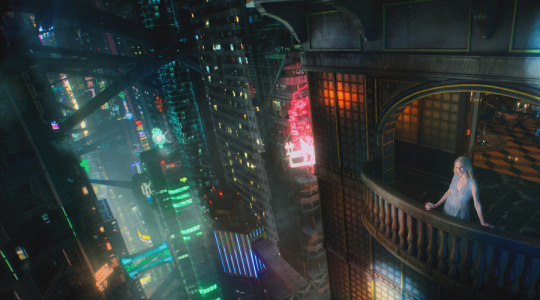
Only once I started writing this list did I find that there is a lot of sci-fi love for New York City and San Francisco (I imagine Tokyo would also make the top 5). The show Altered Carbon takes place in a city called Bay City which is San Francisco unless someone else built another Golden Gate Bridge and covered it with shipping container apartments (cool concept). This city is all about vice and digital pleasures much the same way Future LA is in Blade Runner. Despite having its gritty side this place no doubt has a lot to offer in regards to a nightlife and what I hope is a great selection of food. Just let me pull on my long black leather trench coat with neon trim.
Canto Bight
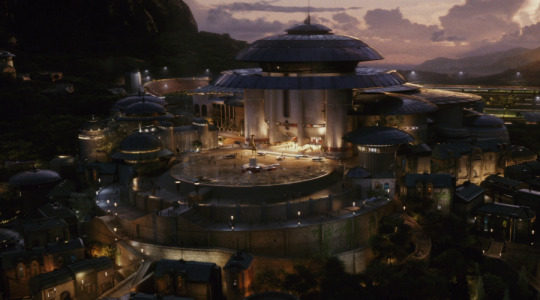
A clever ‘twist’ the Tattooine trope from Star Wars is Canto Bight. Basically suggesting crime doesn't always start from the bottom up but sometimes the top down. While this whole part of the story was literally pointless to plot and outcome of the Last Jedi, I can appreciate another location being added to the vast universe (had it not been cut back by the idiots at Disney). Point is it’s a lavish location with gambling and ritzy living so long as you don't peel back the finish and realize it is basically built on slave labor. Oh, Capitalism.
Castle Black
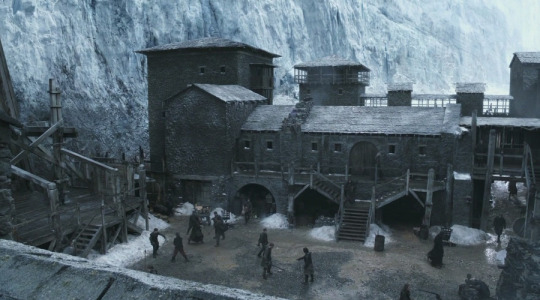
While Castle Black is basically filled with bastards, volunteers, and criminals it makes a pretty good metaphor for aimless people joining the military. Only your enlistment is forever, you're stationed next to an ice wall and on the other side of that wall is ice hillbillies and nightmares. I do actually like some seclusion for some holidays and this works well if I take a bunch of books and mead and spend 3 months reading by a fire while doing some sword practice in the yard with the Crows. Sounds kind of peaceful and I might get to pee off the wall.
Citadel

Yet another superstructure in space shared by multiple species. The Citadel caught many gamers imagination both being a massive space city but also the seat of power between the various sentient species in Mass Effect. The Citadel (like most future cities) has its extreme highs (wealth and luxury) and deep lows (poverty and criminal underworlds). Granted its criminal world is nowhere near Omega’s level of corruption but if Canto Bight showed us anything is corruption can start from the top. The real reason to go here is to party the nights away and drink a bunch, kind of like Singapore and like Singapore, after a week you pretty much hit all the hot spots and ready to move on.
Cloud City

Cloud City for me isn't THAT exciting to go by myself but with my significant other for either honeymoon or weekend getaway? It perhaps can a nice place to relax, stay in a comfortable room, go on long walks, enjoy nice meals and take cloud tours flying around the gas giant and seeing the massive vapor plumes. That doesn't sound so bad, does it?
Columbia
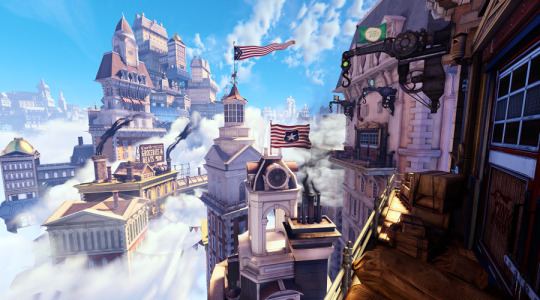
Columbia is a proper steampunk sky city which is nothing short of elegant, beautiful and a marvel in itself. I always wondered how people breathed so high up but that's far from the only concern if you visit a city like this. Behind the vale of beauty is a hyper-religious society, fascism, and racism all hanging in the heavens like some sort of GOP paradise where anyone non-white is kinda screwed. If we managed to cut out the lingering problems of Conservatism in Columbia, this place would be a paradise! Just watch your step its a long way down and railings are only hip high.
Coruscant Jedi Temple

The Jedi Temple, Hogwarts, Highland Mountain, and Kamar Taj all represent a kind of school/academy. An I might make another list of fictional educational institutes we all wish we could sign up for later but as of right now we are on vacation and the Coruscant Jedi Temple has much the same appeal as Castle Black with books to read and swordplay in the afternoon and peeing off one of the spires (preferably off the middle one where the Jedi Council convenes). Naturally, I have also the whole planet to explore but spending time with mystical philosophical laser sword wielding space mages sounds like a pretty unforgettable encounter.
Diagon Alley

Presently the shortest visit on the list, Diagon Alley is pretty much a long street of shops for people to get their magic on. I do enjoy some window shopping and strange old things but really we are here to get spells and wands no? I can't imagine being here more than a few hours but I can see Diagon needing multiple visits because you are bound to miss something and need to make a second trip to fucking find it.
Diamond City

I was split between Diamond City and Megaton as two fallout locations to add to my list. Ultimately living next to a nuclear bomb drove me away from Megaton and living in a baseball field turned fortress appealed to me. I love the care put into the creation of this city by Bethesda, I know I give them a hard time for their multiplayer and money grabbing for mods but the effort put into Diamond City makes it seem like a viable and logical settlement in the Fallout Universe... hell I am thinking about playing that game now after writing this. Oh, what is there to do here? Not much save eat and drink and pee off one of the front walls on some Super Mutants.
L.A. 2049
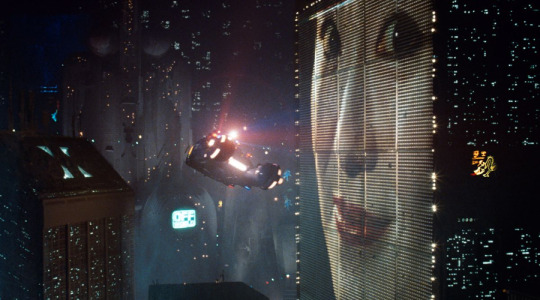
Where Bay City was full of sexy holograms, L.A. 2049 is full of sexy synthetics. Really though this setting really established the idea of Cyberpunk for a lot of people and have one of the early images of vast American cities being pushed closer together and then reaching towards the sky. Like so many other settings it's overcrowded and has its dark side but dark sided cities tend to have some interesting nightlife and like Bay City you can probably do a lot with your time and money assuming you have a lot of both.
Gotham City
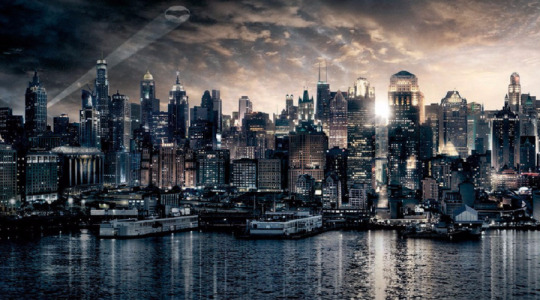
You can probably get more out of Future LA or Bay City then you could from Gotham which is why I won't be trying to sell you on the city. I hear they have a big crime problem and lots of people dressing up as bats. Don’t get me started on this Police zeppelins humming around and shining a spotlight through your window at 2 AM. No, you went to go to the Ice Berg Lounge for some late night Jazz, catch Haly’s Circus when it comes through town, and visit the various museums across the city. Just don’t take any shortcuts and if at all possible pay for a driver to take you around the city, the locals know which areas are safe.
Highland Mountain
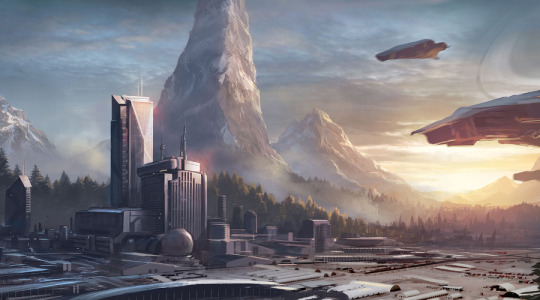
I imagine many of you are thinking “What is Highland Mountain?” and I am glad you asked inquisitive Tumblrs. Highland Mountian is the secret location for the Spartan-II program on the Planet Reach. In other words, this is where Master Chief had his survival training and general training to become a Spartan. If you’re still not with me it's from the video game Halo. Like the Jedi Temple it is more fun to be trained here but as a vacation option, I like camping with some Spartans and roughing it on the frosty mountains in some power armor playing war games. It’s like paintball with soldiers if the soldiers were 7 feet tall and flip over a tank with their bare hands.
Hogsmeade
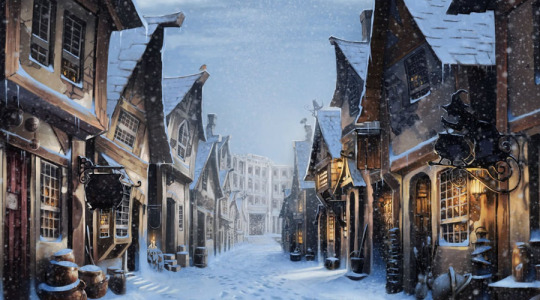
A cozy little-frozen town in Britain called Hogsmeade is basically the main settlement of non-muggles beyond Hogwarts or so Wikipedia tells me. It’s a magical town and has lots to offer in the way of shopping much like Diagon Alley. The benefit of this community is that it is a community; bars, library, shops, restaurants, and more can be found here. Good for a romantic getaway or even raising your kids and making Snowmen during the winter. What else is there to say?
Hogwarts

Say what you will but I imagine Hogwarts might take one of the top 5 places people would love to see. It’s magical, hidden, filled with secrets and a rich history to get emerged into. Despite being just the right age when these books first came out (I was like 12 or 13), I still have not read them (I know... I deserve your ire). Truth is we all kinda wish we could go to school there, personally, I can see myself just reading all the time and experimenting with magic 24/7. I can only imagine how much trouble I might get in with spells/potions going wrong.
Jurassic Park

Not exactly a good track record for Jurassic Park but quite honestly the people overseeing this parks (in regards to the movies) despite being the most brilliant minds in their fields appear to be inept over and over again, as bad as the Sticky Bandits from Home Alone. Beyond that point, a day vacation with the family to Jurassic Park would be amazing and perhaps something we would indulge in every couple of years. Easy to imagine the kids losing their fucking mind over Dinosaurs but then again so would I.
Kaer Morhen
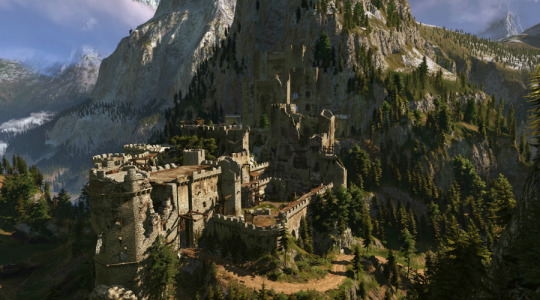
Hard stretch to call Kaer Morhen a school mostly because the students are all old men already trained to kill monsters. This is less about vacationing at this castle and more about living there and fixing up the place. Really, I feel like its the perfect little slice of Scandinavian land to build a long-term residence at. If I was to stay here as vacation spot pretty much reach Castle Black again and repeat without the wall and white walkers.
Kamar Taj

Another school of magic where Dr. Strange learned his abilities along with many other students of magic. I appreciate the seclusion of it. Kind of a Castle Black feels with a pinch of Hogwarts. Like the Jedi Academy, the ‘students’ here are very much adults and there is an appeal to that considering I am 32 now.
King’s Landing
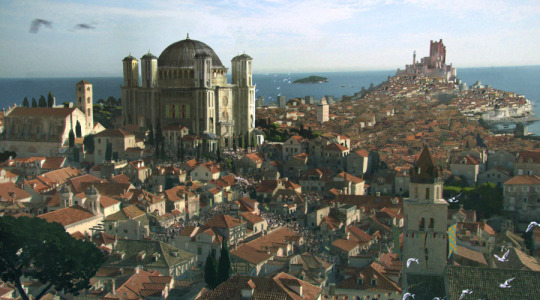
Really though King’s Landing pretty much only works as a vacation spot if you are A) staying at the Red Keep and B) having a bachelor party to enjoy the brothels. Not that any of us would do that sort of thing...
Labyrinth
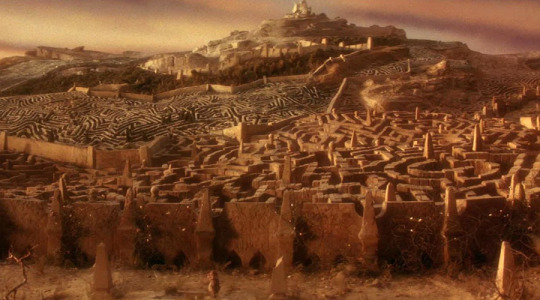
You can either assume this trip will take a few days or a few months. I like the Labyrinth for the same reasons I love Myst and Wonderland. A strange world and I love a good puzzle. Not sure how I feel about the Goblin King and his junk in spandex... I mean I don’t want to rain on his parade but I think I might do the maze in reverse instead of seeing him do his “Dance Magic Dance” in his castle with his junk in my face. No issues here if you’re a gay guy or straight girl that would love King Bowie to do that to you.
Mother’s Cradle
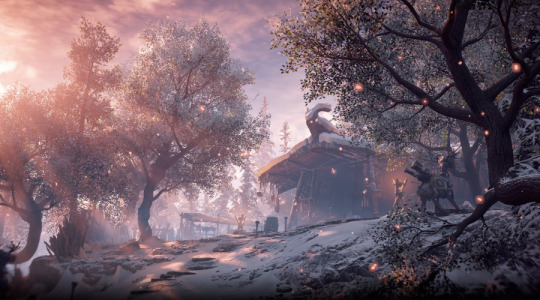
In a world where machines have taken over and humanity had been regressed to primitive tribes, Mother’s Cradle is a secluded valley of protection and nature. If you ever played Horizon Zero Dawn, you can see how peaceful that place is and could easily imagine building a home there and living off the land. I enjoy city living the most but even I can't resist Mother’s Cradle and the community that lives there.
Myst

Who doesn't love a good puzzle? Like the Labyrinth, this place is all about sharpening your wits and solving the puzzles in the world of Myst. I would suggest above all other things take a notebook with you because some things need to be written down. Did I mention it has multiple words you teleport too by opening a book.
New New York
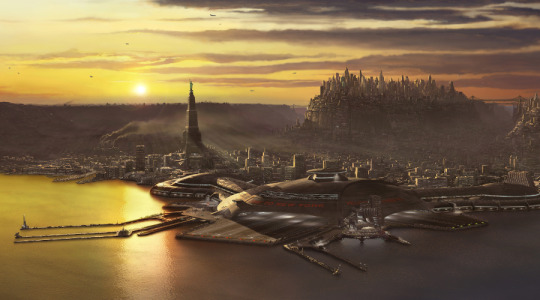
I always wondered why the waterline in New New York in the Fifth Element is so low, really wish someone would explain that to me. Anyways it's better than Waterworld and its good to see the big apple become so large that it absorbed New Jersey. Like most big cities the nightlife would be awesome but why I really want to go here is for the fast food and flights to other planets. I won't lie the uniforms in the future are all about dressing to impress the customers and that's kinda hot. Looking at you McDonalds Girls from 2263AD
New Vegas
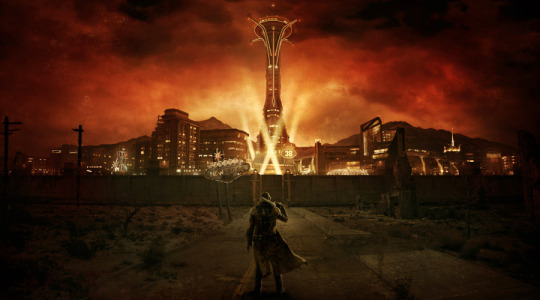
It’s like the Wild West with gambling, mutants, robots, and atomic weapons. You already know Fallout from Diamond city but New Vegas brings its own charm with the gambling scene. I imagine the Sin City is still very sinful and perhaps more violent. You can get into a lot of fun trouble here and who wouldn't want too. It’s Vegas!
Omega

If you were to combine the Citadel with New Vegas then Omega would be the outcome. This mining colony/way station is where crime comes to make a name for itself. The various Mass Effect species can be found within and most of them fight for territories inside its walls. It’s the sins you come from for like gambling, drinking, dancing, fucking, and fighting that make Omega so great. Don’t worry do you don't need to indulge in them all.
Pandora
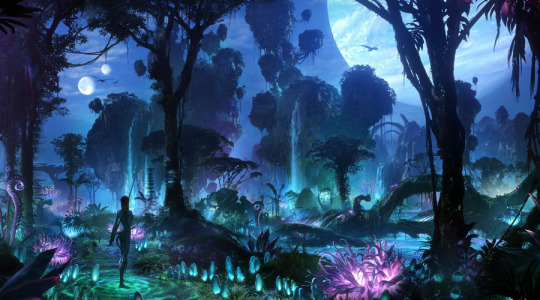
Camping may not be an option in Pandora for humans but with some extra suspension of belief that you can either breath the air without it being toxic or perhaps have a Na’vi body waiting for you. The wildness of Pandora appeals to the hiker in me. I would want to climb the trees and the floating mountains, fly a wild beast or ride a wild horse in this world. The bioluminescence of the world draws me to explore it at night even with the predators lurking about.
Rapture

From my understanding, Rapture throws a hell of a New Years party. Such a crazy party that it turned into a revolution but that's a different issue altogether. The city under the sea makes my list as a more desirable alternative to that of Atlantis with me lacking gill and all that. Like Tomorrowland, this city is driven by progress and is a libertarians wet dream that is until you realize there are always people looking to take power and that being a Libertarian Society is a fantasy.
Risa

This might be the #1 vacation spot on this list because the whole damn world is about fulfilling desires and vacationing. Want to hide away and read a book? Go for it. Massages all day? No problem. Walk out into the ocean and find a boat serving sushi? Apparently, that's a thing from a Star Trek episode. It’s paradise and with their weather controls, there is never a cloudy day at their beaches. Doesn't hurt Risa women are all basically supermodels.
Rivendell

Rivendell, yet another peaceful refuge away from the harsh world. I can imagine this place having comfortable rooms and library somewhere to read. Granted I can't read elvish so I hope they have some proper English books among their shelves. If I do get bored I imagine hiking/climbing the surrounding cliffs and forest might be an option. I am sure I will piss of some elves exploring their hideaway.
San Fransokyo
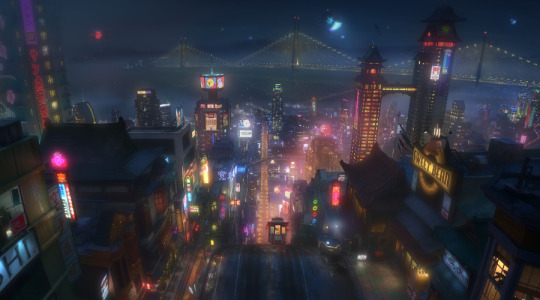
Not the first movie to combine cities into something new. I admit I do love the like the new look of San Francisco and how it makes the world of big hero six feel. I think what makes me want to see this city so much is their altered architecture and more importantly the food that comes with this deep blend of Western/Asian culture. The sushi, the Kobe burgers, and literally everything else is gonna be leaps and bounds better then either city did on their own.
Skellige

There is no party like Skellige Party! Not true Asgard might throw down hard with this Nordic Pirate/Fishing community of the northern islands. Basically, the number one reason to go here is to drink or go to a royal party where you feast, fight, fuck, and drink some more. Don’t think that men have a run at the place, Skellige woman can fuck you up if you don't treat them right. Consider this a helpful PSA.
Skyrim

Truth be told if Skyrim (was to scale) of the real world, it's not a very big province or even plot of land. Think about how fast you can run from one side of the map to the other? What 15? 20 minutes at the most? That's why I kept this location as a broad vacation spot because the keeps aren't THAT big but each one has enough charm that it justifies you visiting them all and get a taste for each unique area. Like Kaer Morhen this place is all about settling down and making a life for yourself. Hell, you could pick flowers all day and sell that to shop and make that your living. Not saying you should make that your career but you could.
Starfleet

The third and final nod to San Francisco on this list (told you they got a lot of love). I always found it interesting that Gene Roddenberry would establish the federation in San Francisco. I might look that up but with the options of London, New York, Washington, and other locations making just as much since he still settled on SF as the home base for Star Fleet. Anyways I wanna go to school here because you know... space travel, alien babes, seeing new worlds and all that jazz.
Stark Tower
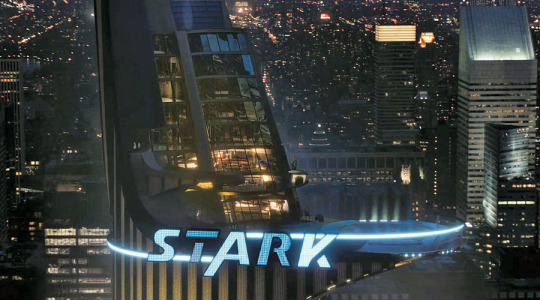
There is no doubt the Stark Tower has a stocked fridge, great food, killer view of the city, and a fully automated AI to improve your day (even if she is watching you shower). The fun of Stark Tower requires one thing and that is for you to invite people to come to a killer party on these top floors. I think we can all agree once you have the party rolling that it will likely go to the break of dawn.
Stormwind
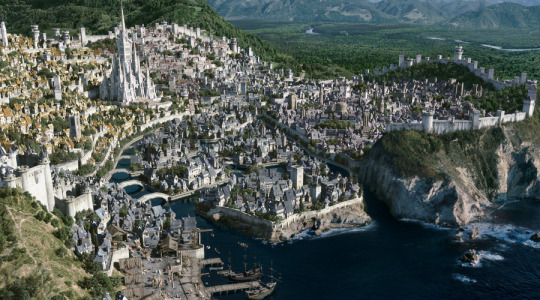
I have no strong Allegiance Alliance or Horde one way or the other. Truth be told I play Warcraft 3 and then stopped never getting into WoW. I suppose the draw of fantasy species pulls me here much the same way it pulls me towards Lord of the Rings. I imagine if you find the might pub you can have a good time but the places of magic will have good books. I suppose I could wander into the forest and bath in a Moonwell and hope for a chance encounter with the Night Elves.
The Shire
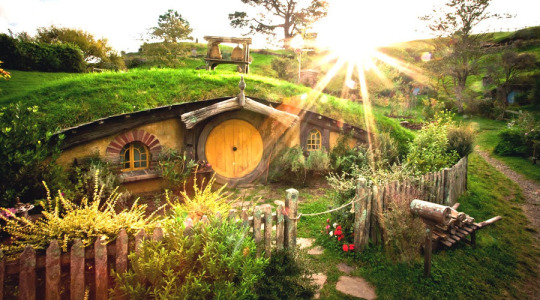
It doesn't take much to imagine that food-based holidays are a big hit with hobbits. So if I was to vacation here Thanksgiving (assuming they celebrated it) or something like it would be the time to visit. Eating, dancing, drinking, and fireworks. Yes, I realize I would be a giant among them and hit my head but I am ok all the same staying in their small community.
Themyscira

Clearly, a theme in some of these hypothetical visits is to meet hot girls. On one hand, I should know better than to post such things because admitting anything like that on Tumblr is slightly sacrilege but you know what fuck that I want to go to an island full of beautiful strong independent women dammit. I don’t mind strong woman, I don't mind a matriarchy society and I don't mind admitting that I like looking at a beautiful woman and I wouldn't mind making love to Amazonian beauties on their beaches. So sue me! I fucking love women.
Thessia

Read the Themyscira post above. Same thing. Only they are a blue alien woman named Asari and apparently they can do something like a “Vulcan Mind Meld” in the bedroom. Sexy.
Tomorrowland
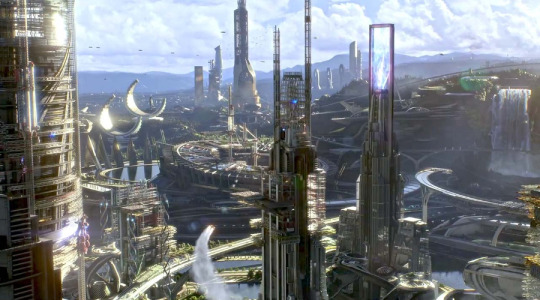
As someone who’s always wondered what society MIGHT be like without religion and uninhibited society focused on knowledge over profit and power, Tomorrowland is an expression of that or at least what I hope it would be like. This is the sort of place you to be impressed by the technology and the marvels of invention. I can imagine flying around a jetpack, experiencing new depths to virtual reality, zero gravity chambers, teleportation and pretty much every other sci-fi invention you can dream up will likely be found here. Hell, I don’t want to visit the world of Tomorrow I want to live there.
New Tristram
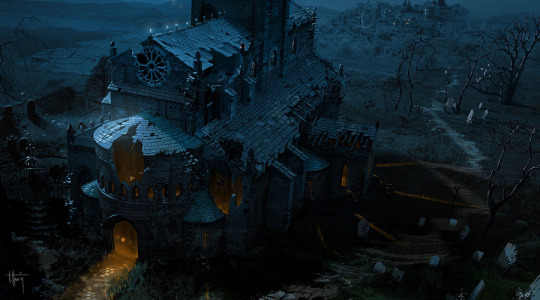
Probably the worst place to visit on my list with all the undead and demons and all that. I can't help but find Tristram a little enchanting with the Gothic Ruins and struggle that is found there. Diablo (the game) has a habit of having building look small on the outside big on the inside which is fine. I personally would like to wander into the layers below and crawl through those dungeons and collect loot. I am not sure if this is still a vacation or some sort of video game fantasy I like to live out.
Tron City

Tron City pretty much feels like nighttime 24/7 but with the arena combat, the races, and the high rise clubs. Its hard not admit there is something exciting about being on the grid. I personally love to derezz myself and spend a few weeks in the world of Tron and maybe bring back Siren or two.
Wakanda

Birnin Zana is the capital of Wakanda and that is what you see in the picture just in case you didn't know that fun fact. The city itself draws me with lots of things; food, music, culture, technology, and architecture. I medium of all things I imagine my stay could be a week or two before I seen everything I care to see. I can imagine (while not really suggested in the movie) that there is a great nightlife here and very engaged community.
Winterfell
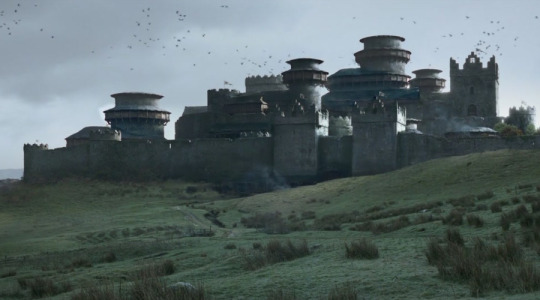
Yet another getaway to swing swords, practice archery, read books and ride horses. Winterfell (despite being apparently the middle of nowhere) is the kind of keep I would love to live in. Not by myself mind you but with a community of people upkeeping the keep. Its a good balance of community and seclusion to read my books. Sansa Stark can keep me company under the animal skins.
Wonderland

Wonderland, you go for the Tea Parties and you stay for the Mushrooms. Pretty much a long acid trip, Wonderland gives you the excuse to bend your mind and alter your perception on reality while encountering a variety of strange and wonderful... um... people. I wouldn't mind making this trip with Alice herself (or the White Queen) but I can make do with going with my friends and ‘feed’ our heads.
#Scifi Worlds#Fantasy Worlds#Fantasy Vacations#Star Wars#DC#Marvel#Disney#Game of Thrones#Mass Effect#Lord of the Rings#Elder Scrolls#Star Trek#Bioshock#Harry Potter#Dune#Fallout#The Witcher#Stargate#Jurassic Park#Avatar#Myst#Fantasy Settings#Scifi Settings#Warcraft
2 notes
·
View notes
Text
Game of the Year 2017 #2: Divinity Original Sin 2

The first Original Sin had one of those video game “issues” that’s only really an issue if you let it be. About six hours in, you’d figured out there were about a thousand ways to crowd controlling your enemies: stuns, knockdowns, charms, fears. With the availability, and reliability, of these attacks, battles often broke down to your mages/archers CCing everything on the battlefield while your warrior dismantled them one by one. This felt exceptionally mean--sadism in video game form--and somewhat abusive of the game mechanics, but combat was so often weighed so directly against you that “cheating” by charming half an enemy squad and letting them rough each other up, or depleting half a gigantic orc boss’s health before combat even starts by teleporting a poison barrel directly onto his face, was really more about evening the odds. Original Sin is one of those games, like Final Fantasy Tactics, maybe, where there’s a billion ways to break it. Unlike Final Fantasy Tactics, you don’t feel bad about it because, from behind a still-growing pile of saves and reloads, you know the game is happy to return your cheesy, scummy tactics in kind.
This is a co-op RPG I’ve been playing with Graz for 120+ hours, according to steam, and we still haven’t finished. It is, among Dark Souls, and Keep Talking and Nobody Explodes (Fast Karate GOTY, 2015), and Resident Evil 5, one of the best co-op experiences of my life.
You can play a skeleton, who has to walk around in disguise to stop everyone from murdering them, and has no need for lock picks because they can simply use, and I quote, their “bony fingers.” The elves are not only cannibals, but they’re cannibals that absorb the memories of their meals, which is sometimes used to learn new skills and sometimes used to solve murder mysteries. Maybe forty hours into the game, I realized this “being forced to experience a living creature’s final moments every time you eat meat” was probably created as an explanation of generic fantasy elves’ earth-mother veganism.
Near the beginning of the game a black cat starts following you around. If you have the Pet Pal talent you can talk to him and he just seems like... drunk? He doesn’t really have anything to say, but he doesn’t go away. If you walk through poison he’ll follow you and get poisoned too and he only has like 50 health so you’re always frantically trying to heal him because the friendly cat who does nothing except meow at me can never die. If you keep him alive throughout the whole opening zone, which also involves keeping him away from fires and superstitious guards who will shoot him on sight, his head clears and he joins your party as a summon.
Also the whole time he’s following you around, there’s this dog who won’t talk to you since he hates cats. But the cat follows you in real time, so if you go to a distant part of the zone and then teleport back to the central hub, the cat is briefly separated from you while it paths around the map to your location, and you can get the dog’s quest to find his missing girlfriend.
There is borderline erotica at one point where, if it’s not explicitly described, the game at least puts the mind worm of “lizard man cunnilingus” in your head. And like... well...............
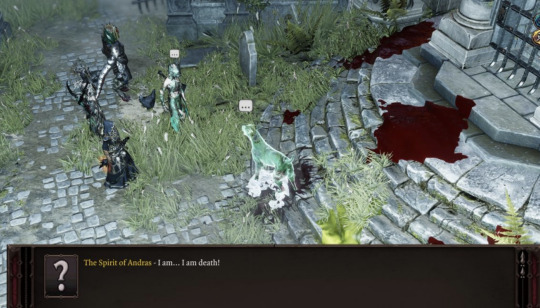
Also there’s another dog later who’s like an evil pet of an eviler grave robber and he refers to himself as Artax: Death Incarnate or something and after you kill him you can use your recently acquired Spirit Vision power to talk to/throw shade at his ghost, being like “...death incarnate, eh...? :) :) :) :) :)” But it’s kind of wasted because even as a ghost (dog (way of the samurai)) he still thinks he’s pretty hot shit.
There are premade characters who have different dialogue tags, most of which seem to amount to jack shit, like almost any RPG with dialogue trees, but the one I picked, Lohse, is some sort of psychic medium who spirits would just hang out in, which was fun until a really bad demon got into her. Sometimes the really bad demon makes her do things that are completely out of her control, like try to murder an elf who’s trying to help you exorcise him, and isn’t it your favorite thing when games present you with a bunch of false dialogue options?
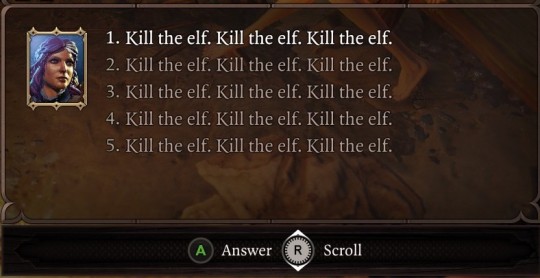
You start Divinity 2 a political prisoner. Unlike Skyrim, where you’re bound for the chopping block and then five minutes later someone’s telling you you’re a god, Divinity sits you on its prison island for something to the tune of 30 hours (then it tells you, more or less, that you’re a god). Because you have a collar on that restricts your scary magic powers, your overconfident jailers basically let you have the run of the place. You are hemmed in just enough to feel your yoke, and much of the early doings is learning where you may and may not go, and which places, just outside of your captor’s line of sight, are okay to seek out dirty business (i.e.: steal a few valuable paintings from).
So you poke at all the nooks and crannies of this just-right sized zone, retrieving gloves of teleportation from the stomachs of hungry lizards, helping that dog find his girlfriend, and making painstaking progress on your escape. This is a tight, interesting area, far better than any of those in the first Original Sin, where there’s not even all that much combat. You bum around with a bunch of prisoners, some of whom certain party members have vendettas against/want to murder, but most of whom are like... chill old ladies that sell you water spells and will give you a free scroll if you give them a shoulder to cry on. Eventually, you kill the mob boss (but don’t let me see you laying a finger on Butter). If you’re a really good person, you kill all the magisters--who are basically the cops of the magic world--on the way out the door.
Boy oh boy, the jump in writing/world texture/everything from the last game. The move from “aggressively generic fairy tale stuff” to “moderately generic CRPG world” doesn’t put the writing in Witcher territory or nothing, but it’s much easier to appreciate the quirks of the setting, which holds strange sidequests where you help a bunch of thousand-year-old wizards who have been cursed to for all eternity to be both 1) pigs 2) pigs who are on fire, when you aren’t dealing voice acting that seems to be literally on purpose trying to kill you.
I’m of two minds about the changes to combat. Now characters have magical/physical “armor” that acts as a Halo-style rechargeable shield, protecting character’s vitality and also making them immune to status effects. Since most enemies have as much armor as they do health, that means they’re half dead by the time they’re vulnerable to being sleeped/charmed/whatever, and so crowd control has substantially depleted in value. Which mutes some of the “controlled chaos” feel of the first game--kind of a let down--but does tacitly nudge you into trying out the rest of the game’s broad spreadsheet of abilities, such as a teleport jump for fighters that sprays fire all over the landing zone, or a summoner’s ability to conjure an Inner Demon which both terrifies her opponents AND punches enemies that come into melee range with gigantic purple mind fists (essentially, we have been given Star Platinums of our very own).
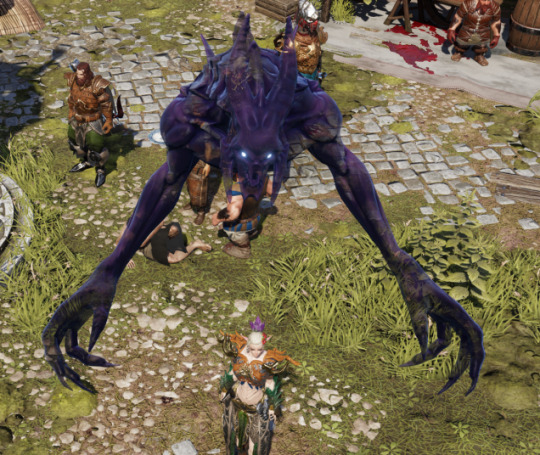
And the uncontrolled chaos, where you laugh at the idiot NPC wasting its turn casting Rain until the next NPC sprays the area with lightning bolts and stuns half your crew, where you forget that the whole room is one big oil surface before you do your flaming teleport jump and now everyone in the room is on fire, or a giant Dune worm erupts out of the ground right in the middle of your boss fight and your enemies start attacking it instead and you’re like “.....so are we friends now?” and it’s like haha, nope, they still fuckin’ hate your guts and this battle just got even stupider and twice as long, so I hope you brought healing potions.
If anything, these changes have the unique effect of making me seriously consider playing this 100+ hour monster game that requires 100% of your attention and thought processes at all time (okay so sometimes I checked in on Fire Emblem on my phone during Graz’s turns, but that’s a given) sometime before the next decade. I suspect higher difficulties return a lot of weight to crowd control abilities.
Even though I know Baldur’s Gate has co-op, I didn’t think they could make a game like this. A gigantic, fully featured co-op CRPG where the other player doesn’t have to tolerate being a henchman at best. Where you can both run around talking to whomever you want and progressing quests however you feel like, and then come back together twenty minutes later to compare notes. Where you spend 3+ hours over two days on a single battle, reviewing plays and planning out turns like a pair of football coaches, micro-managing which of you is going to “waste” their turns conscientiously teleporting a friendly, but foolhardy, NPC out of harm’s way (or turning him into a chicken) so he’ll stop trying to impale himself on the NECRO-TENTACLE FIRE that you discovered, in this very battle, spurts out of every oily blob from the void beyond space after their death. And what’s that, four turns in the fire blobs start spawning?
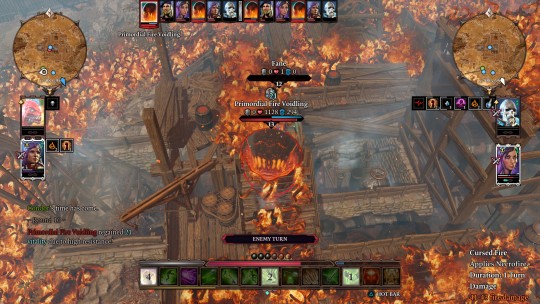
Moreover, though every part of Divinity seems stupid, ramshackle, and tied together with twine, it’s often one step ahead of you. Regular attacks are governed only by cooldowns, but the most powerful spells are restricted by an MP-stand-in called “source” (still, charmingly, pronounced close enough to “sauce”). A difficult resource to replenish, we rarely used source abilities early in the game. But a couple hours after it came to a head, and I started saying “you know, I’m getting a little sick of teleporting back to the giant Source juice box in the hidden basement of this lady’s house every time I want to use Black Shroud,” and was decrying how if they replenished your Source after every fight, making it a per-battle resource, the game would be much more interesting they... give you an ability that functionally does that, and combat becomes much more interesting, on the exact right timeline for me to understand what I’ve gained with this power, having been frustrated for so long by its absence.
I gave up on trying to describe this game concisely. I’m not sure there’s a way to do so, when its whole ethos is jury-rigging systems onto systems and throwing weird events at you constantly and the whole thing chugs along like it was meant to be--damn, it never even crashed until I tried to install a mod. At the strange intersection between narrative and mechanics this game presents, if you think about it, you can almost always do it. You can skip an entire hedge maze by teleporting through its portcullises. If it’d take too long to loot a chest in plain sight of its owner, you can use your Polymorph abilities to turn invisible, pick it up, and send it to the inventory of your lockpicker, waiting outside. You can go upstairs at a bordello. When you wake up, predictably, you’re naked and being robbed. Only, oops, the robbers didn’t reckon your friends would have a magical teleportation pyramid locked onto your signal.
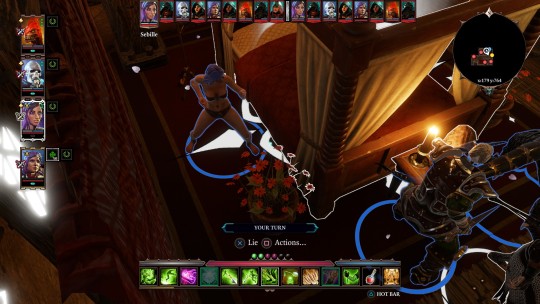
In the same town, this maid crying about losing her owner’s purse robs you, and if you’re sympathetic about it and give her a hug when she asks, she picks your pocket, and the only way you’d know about it is if you check your gold total after the conversation because, let’s be real, she was acting super sketch. I mean damn, the game somehow makes scrolls, the categorical worst item class in all western RPGs, worthwhile. Who wants a one-use item when you can just learn the spell forever? Until the first time you come to truly understand that a short 3-turn cooldown in “Divinity Time” could be the better part of an hour, and therefore a hundred and twenty seven gold for an Armor of Frost scroll is a small price to pay for peace of mind when The Red Prince needs an extra dose of magical armor like right now.
And for all the ways you can bring ruin upon your enemies, all the stupid tricks and techniques that really shouldn’t work but somehow always do, the thing that actually breaks the game? The item that made us look at each other and go “we should probably never use this item again if we want to keep having fun.”
Green Tea.
Conservatively, 200+ hours of my life has gone to these games, and when this one is over, I’ll still feel like it wasn’t enough.
10 notes
·
View notes
Note
I ask this since I know you love Elsa, what is her life and role like post G.U.
BOYHOWDY, LET ME TELL YOU ALL ABOUT ELSA IN AURADON
Elsais particularly interesting in all of Auradon as she’s one of thefew “True” Princesses that buck the Disney Stereotype, and thustheir entire society’s tradition:
Sheis unmarried, has absolute power over her dominion, and none of herpeople look any less of her because of that
She’sone of three who rules over a traditional kingdom without a husband,the other two being Queen Elena of Avalor, and Queen Merida ofDunBroch
Shebucks the trend of princesses needing to be demure and traditionallylady-like, waiting to be saved by a brave hero, and the medievalstandard that women should only stand to the side and cheer on themen as they go off to do work, and be there to welcome them back withdinner and a company in bed when they return
Thisis particularly impressive in that alongside Agrabah and China,Arendelle is one of the major economic centers of Auradon, one of thebiggest centers and facilitators of international trade, aninvaluable link in the global supply chain of the country, and havinga LOT of influence and sway because of all the taxes and tariffs theyproduce for the country, and goods that are endemic to her country,the most famous being their chocolate.
(Youmay think I’m joking, but royals of Auradon take their sweet treatsVERY seriously.)
Herlocal reputation is that she is the “Brains” of the monarchy,being the one to study, craft, and refine all the numerous laws,trade agreements, and government projects and infrastructure that arenecessary to keep Arendelle running at top efficiency and itsresidents, permanent and temporary, happy and healthy.
Ifyou thought that the giant number of ships and diplomats coming inand out of the port trying to make good with the gatekeeper forinternational trade in their continent was complicated, imagineadding the internet, international trade with dozens of othercountries from all over the realm, with all the numerous individualorders they now have to deal with, alongside the much easier bulktrade with countries and corporations.
Acargo-liner missing its delivery of produce to Agrabah can bedevastating to the both their economies and disruptive to the livesof the citizenship, as is an influential duke from Corona notreceiving the special chocolates he needs to placate his wife.
PrincessAnna is the “Heart” of the monarchy, being the one who handlesmost personal interactions with diplomats, fellow royals, orinfluential leaders and individuals, the sole exceptions beingbusinesspersons and lawyers; sitting in for or sitting with Elsaduring meetings and conferences; and always being by her majesty’sside when it comes to public appearances, international events, andespecially whenever Elsa has to do anything with Beast.
Withthe third, Elsa may be free to go around and interact with the worldat large, but she still prefers to stay indoors and work or enjoy hermore private hobbies, the latter of which has expanded to involve theinternet and modern media; and Anna is the only one who canconsistently emotionally (and physically) restrain her when Beastinevitably does something to offend her or otherwise earn herire.
(Moreon the strained relationships between her and Beast later.)
Internationally,she is known as one of the most unabashedly progressive leaders ofAuradon, one of the fiercest proponents for universal education andstricter standards; the advancement of science and technology,especially in the telecommunications sector, and the propagation ofit among the masses; and obviously, women’s rights.
Shehas received both praise and flak because of her beliefs, heractions, and government projects:
WithEducation, majority of the states dislike her stance of completelyremoving religion and the numerous customs associated with it, alongwith her push for serious and possibly criminal disincentive andpunishments if a legal guardian/parent/state fails to comply with her“education for everyone” philosophy.
Majorityof the negative press comes from the already financially troubledmiddle and working class complaining about the extra costs of sendingchildren to school such as lunch money, transportation, and ofcourse, the lackluster and highly variable states of public schoolsand governtment-sponsored institutions that gave states like Londonan unfair advantage, and the inherently different competency levelsof teachers, or the unique geographical and cultural challenges ofthe many remote villages and places without concrete roads, much lessreliable mass public transportation.
Thecost issues is not helped by majority of the disincentive beingmonetary fines, as “jail time” is equivalent to a trip to theIsle of the Lost, and Elsa was never a fan of that, to say the least.(Again, more on that later.)
WithIndustrialization and the Information Revolution, she’s seen as ascapegoat or a heavily demonized figure by the working classes andthe industries that have been rendered obsolete, or were vastlyshrunk or forced to adapt in a hurry in the wake of the increasinglyautomated and globalized nature of production and commerce inAuradon.
Itdoesn’t help that there are still media figures who are willing toslander her, making fun of and controversies out of Elsa’s knownhabit to stay inside her quarters and surf the internet and watchanime for majority of her free time.
Oneof the most common sound-bytes is, “This ‘Queen’ just wants tostay at home all day, dealing with fiction than reality!”
WithWomen’s Rights, the only thing I’ll say is that sexism andmisogyny is well and alive in Auradon, no matter how manycelebrations they are about how equal and progressive every state hasbecome.
Elsasums up the irony of her plight like this:
“Iam constantly receiving insults and threats from women who wouldn’thave been able to publicly express their opinion without Feminism,oftentimes sent from phones they’ve bought from the verycorporations they demonize, using technology and infrastructure thatwouldn’t have even existed or been at the level it is now if wedidn’t support education and science so much.
“’LivingLike Royalty’ indeed.”
Itdoesn’t help that Beast has at many points publicly and vehementlyopposed policies and causes she was supporting, only to laterbacktrack and get much if not all of the praise when he and thepeople finally realized how beneficial it was to their lives.
Mostpeople only remember the biggest three disagreements she’s ever hadwith Beast, however: the enactment of the Magic Ban, the creation ofthe Isle of the Lost, and his changing Auradon’s originalgovernment structure from an international union of all the manystates while retaining their individual powers, to the FederalGovernment it is now with Auradon City and Beast at the top.
Allthree happened amid a very bad time for all the royals and Auradon ingeneral, the first two years After Great Uniting when the “Honeymoon”period was over and so many cultural, economic, and political clasheswere happening all over the place.
Asthe one who had initiated the Great Uniting in the first place, alongwith being the first contact of many of the states for inhabitantsacross realms, Beast, Belle, and his court had handled majority ofthe international problems, even if they weren’t formally grantedthe absolute authority they have today.
Elsawas busy with keeping the peace and sanity in Arendelle as it was amajor international hub of political and economic activity A.G.U. asit was B.G.U., but all those policies prompted her to put her regentand Anna on the throne as she took an emergency trip to Auradon City.
Thescene is oftentimes heavily dramatized in historical documentaries,though the “ugly truth of the matter” is oftentimes made muchmore pleasant for a variety of reasons, much to Elsa’s dismay. Theactual event was as follows:
Beastsitting in his office, drowning in paperwork that is being siftedthrough by Cogsworth and a small army of secretaries, lawyers, andadvisers. Belle wasn’t with him at the time, as he had encouragedher to take a vacation from all the work she was taking on herself intrying to bring peace and sanity to Auradon.
Thegrand double doors are locked, and have been for hours, Beast havingstrictly ordered that only a handful of incredibly urgent andvery specific business and emergencies be allowed to add onto theliteral mountains of paperwork he’s already dealing with.
Suddenly,it’s unlocked from the outside, the sound of the key turning thegear mechanisms like a massive explosion to the inhabitants, asthey’d had nothing but the sound of furiously scribbling pens andhushed discussion for so long.
Lumierecarefully peeked his head in. “Your Majesty, you have a veryurgent visitor–”
“Tellthem to go away, I’m busy!” Beast says.
Lumierefrowns. “Your majesty, I’m afraid she–”
Bang!
Theother door opens with a blast of frost and hail, slamming into thewall, the crystal doorknob shattering from having been frozen. TheRoyal Guards that had been chasing yelp and jump back as a giant wallof icicles erupt in the doorway, barring them and Lumiere fromentering.
Elsadoes not notice the cries and complaints of Beast’s aides or thefear in their eyes as she storms up to Beast’s desk, ice spreadingfrom her feet, seeping into the carpets, and crawling up the walls.In her hands, she carries two thick sheaves of paper, the physicalcopies of the first drafts of the Isle, and the Ban.
Beastgroans and rubs his temples, his reading glasses dipping lower downhis nose. “Elsa, now is not a good time…” he starts.
Slam!
Elsathrows her papers down onto Beast’s desk, scattering the documentshe’s already reviewing, skewering the signature he was trying tomake on one. “What are you thinking with these?!” she demanded.
Beastscowled, and shoves them to the side. “Elsa, I had someone send youan e-mail with everything you wanted to know, just like you asked–”
“Iread the damned e-mail, that’s why I’mhere!” Elsa cried. “Have you gone mad, Beast?”
Beastgroaned. “Is this about the Magic Ban? Because I think your kingdomwill do just fine making your ice palaces and skating rinks theold-fashioned way.”
“Thisisn’t just about what I do for my people for the sake ofrecreation, Beast!”Elsa cried. “Haven’t you seen what it’s like for the otherrealms? You’ve met Flora, Fauna, Merryweather, Genie, the FairyGodmother, the Blue Fairy, Yen Sid, Merlin—magic isn’t aplaything for them and thousands of other mages, it’s theirlives and how they make a living!
“Andanother note, what in the hell is this about a ‘RemoteIsland Prison’ for all criminals?!”
“Yourmajesty Elsa…” one of Beast’s aides said as they stepped in, ahand held out.
Beasthis hand on their chest, and gently pushed them back. They loweredtheir arms to their sides as they quickly stepped back; the otheraides follow suit, many of them holding the documents, tablets, andpens in their hands like they were shields or weapons.
“It’sall business, Elsa,” Beast said. “All those people are going tohave how to get by without magic like the rest of us, becauseotherwise they’ll have an unfair competitive advantage overmundanes and that’s going to kill so many markets.
“Andfor another thing, if we get rid of all the villains and theirlackeys, we won’t have to spend so much on the Royal Guard to stoptheir mischief, AND we don’t need to strain our agricultural sectoranymore than it already is.
“Icall that a win-win!”
Elsastared at him. The room literally and figuratively dropped severaldegrees as the aides began to shake, both from the cold and fear.Many of them start to slowly inch towards the nearest windows.
“Youcall this a ‘win-win?’” Elsa asked, her voice devoid ofemotion. “Is that what these people are to you, Beast?Figures on a sheet, something that affects your bottom line,dead-weight you can just throw overboard?”
Beastslammed his hands on the table and shot up. He has great deal overElsa physically in height and weight, but even that and the blazingfire in his eyes doesn’t intimidate her, the Queen of Arendellestanding as tall and cool as before.
“Elsa,I am the King of this Castle you’re in, and you will show merespect, as a guest should,” Beast said, seething.
“A‘guest’ who also sits on your advisory board, whom youformally and publicly invited and made a big show of telling thewhole world just how glad you are to have my expertise,” Elsareplied calmly. “These new orders of yours are disastrous, Beast,however you paint it:
“Socially,you’re going to be sentencing for life a good third of our totalpopulation, ripping families apart without hope of ever seeing eachother again, many of them victims of circumstance and forces beyondtheir control as the studies from London will tell you.”
Shenarrowed her eyes. “I’m assuming you read them, right?”
“Ihad someone sum it up for me,” Beast replied.
Elsaresists the sudden, magnetic attraction between her forehead and herhand. “Economically, you’re devastating a giant portion ofour working class, ripping out a majority of the people who do allthe dirty, inglorious work that keeps kingdoms like ours running, andyou free to sit around all day dealing with paperwork whileyour servants clean, cook and bring you food, and read the damnedpaperwork you were supposed to.”
Beastgrowled and bared his teeth. “Leavemy staff out of this.”
“I’mmerely stating a fact, Beast, I can’t apologize becauseit’s true,” Elsa snapped back. “This isn’t even just thepeople who scrub your floors, clean your dishes, and keep your castlefrom crumbling apart—these could be the same people helping youdraft laws, communicate with ambassadors, and keep you from drowningin paperwork in ten years, after we put them through a propereducation!”
“Wedon’t know how effective your fancy ‘universal education plan’is going to be, all we know is that it’s going to be as expensiveas shit and hard to implement!” Beast roared.
“Anddoes that mean we shouldn’t TRY?!” Elsa cried. “This isn’t aquestion of cost and figures, Beast, this is a question of morality,the ‘Good’ thing to do. Is this how you want to treat all theproblems in our new world, Beast?
“Lockthem up or put them in chains, hide them away from the rest of theworld where they can’t see them so everyone can go about theirlives pretending is sunny and shining while they suffer cold andalone, do the same thing that happened to me?
“Thesame thing that happened to you?”
Beast’shands clenched into fists, his jaw clenched so tightly the veinsunder his skin looked like they might pop at any moment.
“Thisisn’t how a monarch should rule, Beast! This isn’t how this ournew world is supposed to work! You can’t just demonize people,shove them in a drawer where they can’t bother you, make them outto be monsters like you were!
“Youdon’t get a second chance at life and freedom so you can take awayeveryone else’s!”
“Shut.Up.”
“No,I won’t shut up!” Elsa cried, frost pouring from herfingers, her magic seeping into the desk and all the paperwork atopit, turning paper soggy then into ice, ink freezing inside pens andbottles. “I am exercising my first amendment of our Constitutionthat you signed, that you agreed to follow, that allowsand protects my right to tell you that you are making a hugemistake all of us are going to regret!”
Crack!
Beastslammed his palms onto the desk, the ancient, sturdy wood shatteringinto pieces from all the ice that had seeped into the grain.Paperwork, pens, and ink jars fly off as he roars and sends themflying off every which way and out of his face.
“THENGET OUT! OUT! NOW!
“THISIS MY CASTLE, MY RULES, AND AS THE KING, I FORMALLY DECLARE THAT YOUARE FOREVER BANNED FROM EVER SHOWING YOUR FACE IN MY KINGDOMEVER AGAIN!”
Elsanarrowed her eyes at him. “We will speak again, Beast,”she said quietly, before she turned around and left.
Thebarrier of icicles fell as Elsa crossed through them. The RoyalGuards standing outside with their swords drawn were prepared tofight her and forcefully take her out of the castle and to a privatejet headed straight back to Arendelle, but the constant, violent,freezing winds and hail pouring out from her make them think twice.
Lumierepeers in, and quickly beckons the terrified aides out. He closes thedoors after the last one, leaving Beast the only one in the room. Thestaff, aides or Royal Guard, all bow their heads and ignore thesounds of roaring, rage, and destruction that echo from Beast’soffice.
TheMagic Ban and the Isle of the Lost are soon passed, with the blessingand the enthusiastic support of majority of Auradon’s residents.
Elsais one of the figureheads of the movement that tries to prevent theirpassing, but unfortunately, neither she nor her allies could inspireloyalty in the masses like Beast does; Belle was on his side,believing that she could eventually steer him towards rescinding thedecisions and supporting what Elsa and the other, more controversialroyals wanted; and the union of the Fae and the soon-to-becomeIslanders quickly dissolved after massive in-fighting, factionalism,and the increasingly evident fact that technology would soon outpacemagic and leave half of them behind.
UnlikeDunBroch, which seceded from the Union during the chaos, Elsa firmlyexpressed her decision for Arendelle to stay. “Leaders don’tleave the table, they stay, even if the head of it is prone toflipping it over,” in her words.
Shedoesn’t have as much power as she would like, as Auradon quicklyturned into the Federal Government it is when the individual statessaw the need to unify under one banner with actual executive power,but she is a part of the unofficial, but no less powerful andinfluential Trade Triumvirate of Auradon, the other members beingAgrabah and China.
Alot of Beast’s dumber or less popular decisions among herprogressive allies were kiboshed when she and the others casuallythreatened to secede and stop remitting their billions in taxes andtariffs to Auradon City.
Allof the above events have obviously made their mark on Elsa, her hairthese days looking more gray than white, having gained weight andmore than a few wrinkles from stress eating and the stress thatprompted it, and lost much of her faith in humanity and the“Goodness” of people after seeing Auradon time and againsupporting Beast to their detriment, and praising him when it wasmostly the individual states’ actions that actually brought aboutthe change.
Therewas a push to put an end to the monarchies that govern Auradon nowthat the world is changing, but she is wary after seeing the kind ofpopulation that would constitute a democracy, and the leaders theywould likely elect.
She’salso gained something of a snarky streak to her, frequently seenwhenever she uses social media: “If I seem angry and pissed off allthe time, it’s because I am,” is one of her favourite lines.
Still,it’s not all that bad.
Feminismhas made life infinitely more pleasant for her and all of herkingdom, and she’s good friends with the other princesses/queens,especially Merida, Jasmine, Mulan, and Belle. (Her stance is that sheplatonically loves the woman, viciously hates the man sheloves.)
Inspite of the lack of credit and flak she gets for being one of thekey proponents of advancing Auradon’s more helpful policies likeinternet access for everyone, better standards for education, and theglobalization and industrialization of trade and production, it makesher happy whenever a little child tells her that she wants to be aruler just like her when they grow up:
Someonewho doesn’t back down from her beliefs, even when the entire worldis against her.
Andof course, the Great Uniting brought her Anime, video games, and theInternet. “Oh, how I wish I had these when I was trapped in my roomfor over a decade…” in her words.
45 notes
·
View notes
Photo
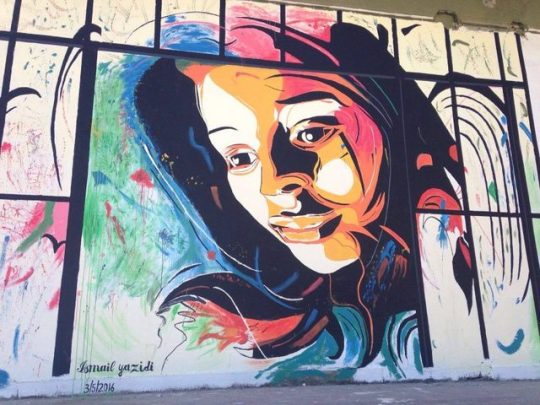
In A Greek Refugee Camp: A Volunteer's Notebook
By Mai El-Mahdy
Licensed as Creative Commons Attribution 3.0.
Syrian refugees in Greece. By now there are thousands of blog posts, newspaper articles and eyewitness accounts that tell the stories of entire families drowning in the ocean, in desperate hope for a life free of warfare and poverty. I’m sure there are even more on those who eventually survived the ferocious waves, only to move into inhumane, “temporary” camps where they end up spending years. But for better or for worse, I’m not going to talk about the refugees, the lives they left behind in Syria or how they ended up in Greece. I want to talk about the current conditions and the role—or lack thereof—of those of us who try to help them, in bringing an end to this humanitarian crisis.
Recently I spent a couple of weeks at Greece’s Ritsona camp, a hub for five different humanitarian NGOs, alongside the UN operations. Ritsona is an old military base located outside Chalkida, the chief town on the island of Euboea, about an hour’s drive north of the centre of Athens. Its population is roughly two-thirds Syrian, with the remaining third made up of Kurds, Iraqis, and Afghans.
Sunken dignity
One of the harsh realities about life in the camps that is hard to fathom, let alone survive, is the absence of self-respect—dignity that has dropped so low it’s as if it was eaten up by the fierce waves before sinking to the bottom. It’s the dented sense of dignity that makes a person happy to move out of a tent into some makeshift caravan container box that becomes your “temporary” shelter for months and months. It’s the type of dignity that is all but lost when your entire livelihood is at the mercy of NGO workers who, through their authority and the decisions they make on people’s behalf, teach the refugees to accept the little they get, and be happy. Why do this, when these people are already broken? Do we volunteers always know what’s best for them? Would we allow others to make similar decisions on our behalf?
It’s not about freedom of choice; it’s not about allowing people the space to make their own decisions and mistakes. It’s about self-determination. Refugees take every single imaginable risk, relying on factors way beyond anyone’s control, only to arrive—miraculously—at a camp and submit to someone else’s decision-making, regardless of how good or bad those decisions are.
“Let’s teach English!” Everyone needs and wants to learn English, right? “Let’s buy toys for children,” overlooking the desires of parents, and the children themselves. Queuing up for food or clothes is part of the harsh reality of accepting that, due to circumstances beyond your control, you have become less valuable of a human being.
Refugees don’t want to queue for ages for food or clothes: they want to be treated as human beings, just like a black man in Apartheid South Africa, a Palestinian in the face of the Israeli occupation, or a woman anywhere in the world today. Part of the pain is acknowledging, while you stand in line, that few outside of your war zone would ever have to endure this or even entertain the thought. It is the frustration of being offered the non-choice of either being grateful that you’re in a queue with food at the end of it, or of being featured in a photo shared on social media that makes people feel sorry for you.
Perhaps we should look at the treatment of refugees as a right they have earned for themselves, not as charity that we choose to give to them. Perhaps we should focus our efforts on allowing them to fight for themselves. Perhaps it is simply about paving the way for their self-emancipation, regardless of where it leads them, and especially regardless of where it leaves us. We need to focus on educating them about their rights based on the country they are relocated, caring for their health, providing education for them and their children, etc.
Perhaps we should look at them the way we want them to look at us: with dignity and self-respect.
Are we really helping?
It’s funny how, as volunteers, we’re expected to arrive on the scene and push, along with everyone else, to get the wheels in motion. As though we’re not part of the story, but instead temporary outsiders brought in to perform a specific mission. But whether we like it or not, we are part of the narrative and influence it, significantly.
As individuals, we struggle with our egos. It’s one thing to recognize that—and in fact, very few volunteers are strong enough to do even that. Suppressing our egos, however, is a totally different story. It’s probably inevitable that volunteers find it easier to feed their egos than feed the needy. And the reward is so tempting that many forget to stop for a minute and ask themselves: are we really helping?
It’s no wonder so many volunteers pay special attention to children, who become quickly attached. But how does that help?
Volunteers can’t help but feel superior. In the camps they stand out like a sore thumb, and that’s not always unintentional. Volunteers often see themselves as providers of a valuable service, as making a great sacrifice of time and expertise. And they expect others to be gracious and remind them what great human beings they are for doing what they do.
But it’s not a service—it’s the refugees’ right. And this shouldn’t be debatable.
Once, at one of the stores where we shopped for the people of Ritsona camp with donated funds, I tried to bargain with the cashier to get more for my donated buck. The cashier, a fellow Egyptian making a living across the Mediterranean, agreed to “hook me up.” But instead of reducing the cost, she offered to write me an invoice for a higher sum. According to her, many volunteers and NGO workers accepted the fake invoices and pocketed the difference, so it was clear to her that I was new to this. And no, she did not budge on the price.
That’s only the tip of the iceberg. Some volunteers finance their travel out of the donations they receive. In spite of pleas for greater transparency, few NGOs actually publish the details of their finances. And even fewer donors ask for the details. If it’s change we’re after, this is probably a good place to start.
In my opinion, the best way to help refugees is by bypassing the NGOs altogether. It’s not difficult for us to connect directly with refugees. They’re human, just like us, just with different circumstances that suck. Treating them as patients with some disease or disability doesn’t help.
A friend of mine has a different take on this. He relates the story of a German doctor, an older gentleman, extremely professional and meticulous about his work. It’s his job to treat patients to the best of his ability given the facilities provided. From morning till night this doctor receives patients, diagnoses them, treats them. He doesn’t speak the language of the country where he works, and is very distant, almost cold. But he treats every single person he comes across, and he sets up and develops the medical facility and trains the workers so that the project can sustain itself after his departure. Many might not know him, care about him, or even remember him, though he is the one who directly helped and advanced the community. No credit. No showiness. No emotion. Just pure problem-solving.
I don’t necessarily disagree. NGOs impose strict rules on volunteers, one of which prohibits staying at the camp past 5pm. I hated this rule, so after a couple of weeks, I moved out of NGO housing and into the camp. I stayed with a refugee friend and her two daughters in their container. I would never argue that I was living their life, but I will say that I was observing it through a sharper lens.
While I agree that being distant and professional may be highly efficient and effective, I think that closeness also helps. Yes, we eventually leave; and sure, we may invest more time and effort in forming emotional bonds with the refugees than in providing tangible deliverables. And I won’t deny that I’ve learned more from the refugees about the Syrian cultural and political context than I’ve shared my own knowledge.
But by establishing close bonds we remind others—and ourselves—that they are human. And we become more human in the process.
Hospitals Don't Always Speak Your Language
The day to-day medical needs of Ritsona camp residents, of which there was an abundance, were left pretty much unattended. In emergencies, however, the Greek National Emergency Medical Services (EKAB, Ethniko Kentro Amesis Voitheias) would transport residents of the camp to and from the nearest hospital.
No one likes to go to the hospital, but when you’re a Syrian in a foreign country, it’s even worse than you imagine. Refugees are immersed in a sea of loneliness and fear of the unknown. You can see it in their eyes. And the harsh conditions of the journey to the camp leaves the majority of children, especially, with severe respiratory problems.
Many of the Greek doctors, however, didn’t even speak English nor did they have translators, and most patients could express themselves only in either Arabic or Kurdish. Often, residents would spend hours awaiting emergency care at the hospital, only to lose hope of ever understanding what they needed to do to get treatment, and leave.
At the camp my Arabic came in handy, as my job was to accompany the patients. Last May one of the NGOs at Ritsona pioneered a unique initiative dubbed “Hospital Runs”; that was the team I worked with. It’s a program organized in collaboration with the Red Cross that operates under the license of the Greek Army. They provide medical transportation, English, Greek and Arabic interpretation, and intercultural and medical assistance. The team also helps with bureaucratic procedures.
I was proud to be a member of that team. Each day we’d hop over to Chalkida or trek all the way to Athens, returning in the evening after having handled whatever problems, cases and complications had been thrown at us.
Sometimes the hospital staff made us feel unwelcome, scolding us about coming in with muddy shoes, indifferent to the fact that the camp is basically built on mud. I remember arriving at the hospital one day to find a young woman, clearly Arab and most probably from the camp, all alone, with nobody attending to her. She had clearly given up on trying to communicate or to save herself from whatever pain had piled on top of everything she had brought over to the continent. She gave me her details and the number of a loved one, so that I could communicate to them in the event she didn’t make it. Thankfully, and against the odds, she survived.
I guess I just can't fathom how borders and bodies of water can ultimately decide who's granted the opportunity to climb to the top, and who will be left to drown, and sink to the bottom.
Mai El-Mahdy is an Ireland-based Egyptian who works in tech. She was one of the millions who took part in the #Jan25 revolution, and she looks forward to being part of the next one.
26 notes
·
View notes
Text
May 20: Croatia & Bosnia & Herzegovina, Oh My!
Raise your hand if you know where Croatia is!
(I didn’t a month ago)
Raise your hand if you know the difference between Bosnia and Herzegovina!
(I didn’t until a week ago)
Raise your hand if you can name 1+ city in either of those countries!
(I still cant- Slovenian is a tough language)
And I’m back! It was our second to last trip and to be completely honest, I had low expectations. What kind of fun would a country I’ve never even heard of be? Thank GOD Croatia, Bosnia and Herzegovina proved my incredibly ethnocentric self so so so wrong and blew me away.
Before I went, all I had heard about the entire region was:
“Oh my gosh, it’s so beautiful!”
To which I immediately thought:
“Oh my gosh, literally everywhere I’ve been is breathtaking- that’s nothing new.”
Furthermore, as if to add to my bad attitude in going to Croatia, Maddie and I got home from Greece on Thursday afternoon, and at 6:45am Friday morning we were in a death-defying taxi ride to the airport preparing for a FULL DAY of traveling. We didn’t finally touch down in Croatia until 4:30pm. It’s hard to be excited and positive at that point. The late emergence of my 12-year-molars and an overcast day took a bad mood to a downright nasty mood.
We stayed in Villa Antea, an apartment complex only a short bus ride away from the heart of Dubrovnik- not the capital of Croatia but a cultural hub. I did a bit of research on the country I was in: Croatia is a long skinny country bordering the Mediterranean sea. It was part of the former Republic of Yugoslavia and was occupied by the Axis powers in WWII. The people are known as “croats” and the entire region went through some very serious political and ethnic wars just a short while ago in the early 90′s (I’ll talk about that more later). Croatia has more than a thousand islands and a cliff-y coast line, which we were snuggled up against.
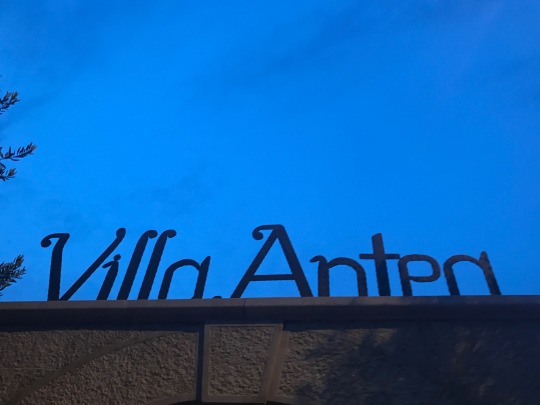
Dubrovnik is very close to the southern border of the country and is a UNESCO World Heritage Site as it has a long history as a maritime trading port. We focused our energy in the Old City portion of the city- constructed in the 13th century. The Old City had narrow brick-laid streets, surrounded by massive walls and sprinkled with clock towers and churches. Maddie and I ventured into the Old City with no particular plan and were engulfed by history.
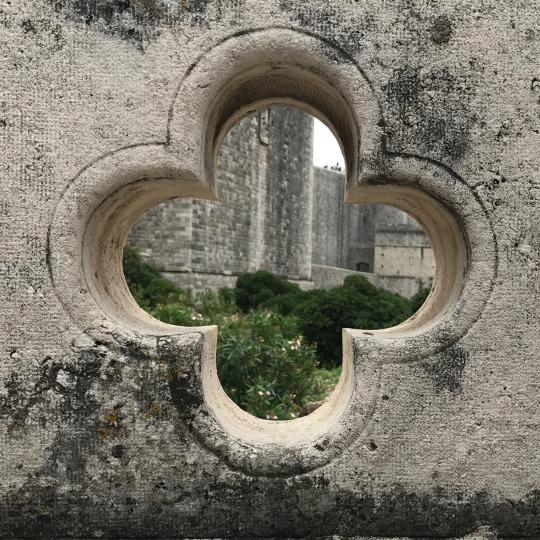
(I’ve become a big fan of architecture since coming to Europe- it’s rather hard to not)
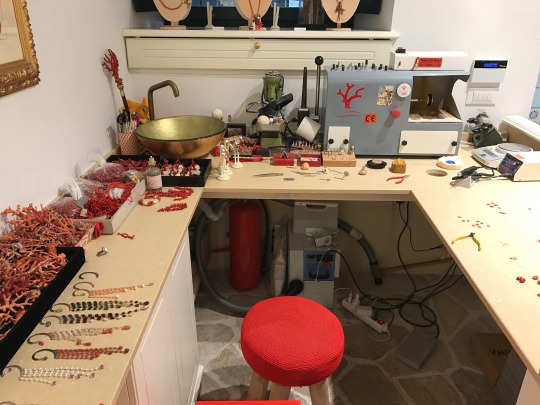
(We stumbled across a workshop where coral jewellery is made and the craftsman even gave us a little presentation and helped us understand how pieces are priced)

(the cute paved streets were lined with old buildings and artisan storefronts)
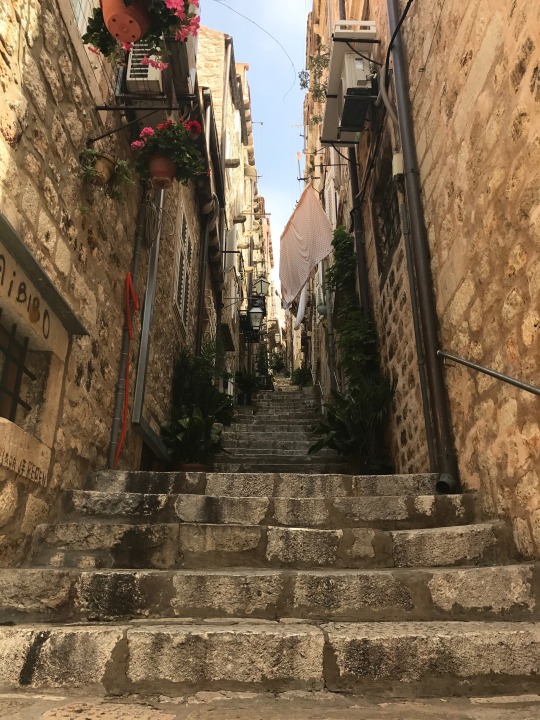
(A staircase leading to nowhere)
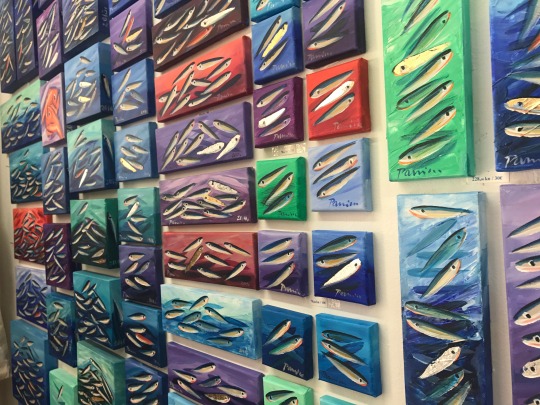
(One of the shops we went into was an artist trying to sell these adorable minnow paintings. They reminded me so much of snorkeling and the little fish that live along every coastline I’ve been to. It was my *splurge* of the trip)

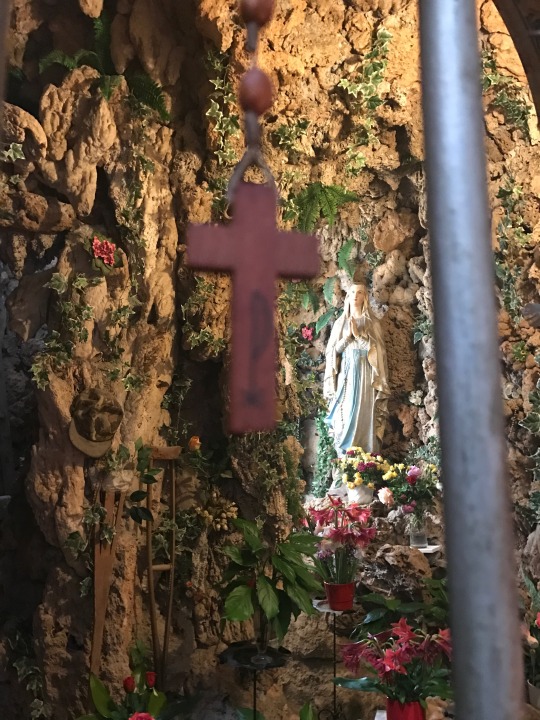
(most churches are open to the public so long as you remain respectful. We went inside two or three of the churches because Maddie loves looking at the European staples and found this adorable little grotto)
Before long, we had accidentally discovered the harbor and took a glass bottomed boat out for a cruise. It offered some really amazing views of the old city, as well as a really neat perspective of the seafloor and coral reefs. Considering I had just been snorkeling in crystal clear waters just a few days ago, I was underwhelmed by the glass-bottom part of the experience, but the Captain of our little boat let me sit up by him where I got to feel the wind in my face and get splashed by the cool waters.

(all smiles from this gal!)

(just a neat experience!)

(we got up close to the caves that are carved into the coastline)
So as if that wasn’t enough for the day, we still had two things we wanted to try: take a cable car to the top of the mountain over the city, and climb the city walls (certainly not experiences for those who are afraid of heights). The cable car was a pleasant experience that offered panoramic views of the entire city. Maddie and I enjoyed a pre-dinner snack of draft beer and ice cream at the edge of the mountain before heading down to climb fifteen million steps to summit the old city walls.

(a *candid* edgy pic of me at the very top, in front of the Old City)

(a foggy day gave us a 10% discount at the restaurant, but every now and then the fog would clear and we got spectacular views. You can clearly see the outline of the Old City in this picture)
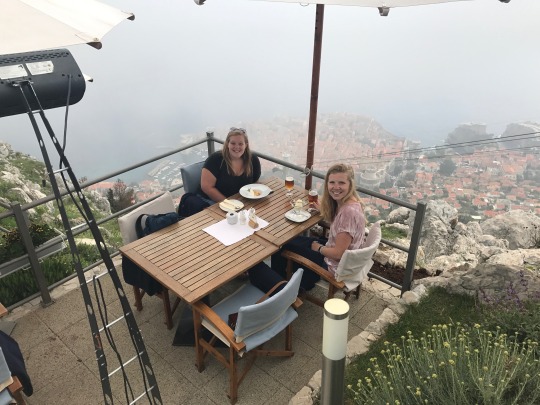
(Cutie roomies- there is nobody I’d rather spend this time with!)
youtube
(the ride down the mountain- sped up for your viewing pleasure!)
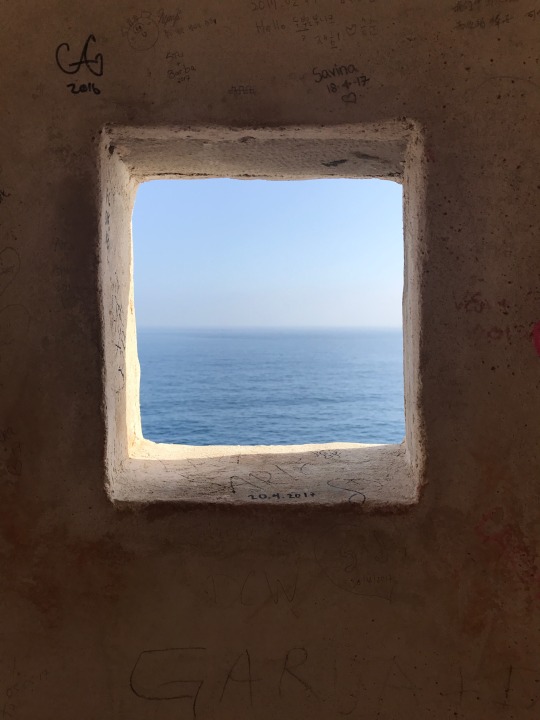
(it blows my mind that people are writing on a UNESCO World Heritage site. Unfortunately, graffiti like this has been peppered on much of the historical sites I’ve viewed)
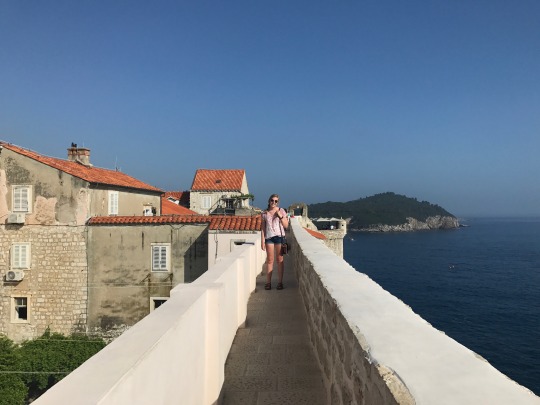
(the walls offered panoramic views of both the city and the sea. I could get used to this!)

(on the left is the church where we found the little grotto. On the right is the mountain we took a cable car up!)

(sharing a view with the seagulls!)

(Dubrovnik is definitely a foodie’s paradise- especially if you’re into eating in unique and interesting locations!)
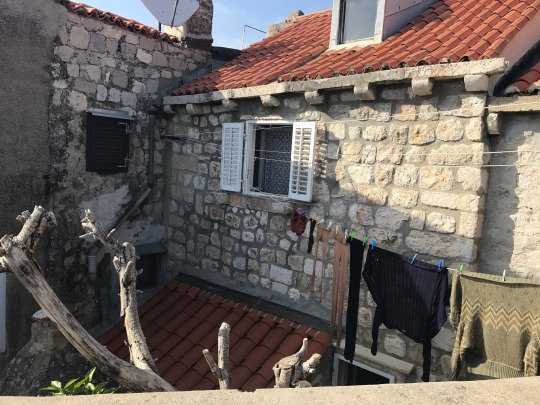
(I do feel a little bad for the residents who live near the city walls. Privacy is clearly scarce)
The next morning, Maddie and I got up early to venture to Cavtat, a small fishing village with crystal blue waters and a much smaller tourist presence before going back into the Old City with our pal Kalinda for drinks and some stray-cat snuggles. It was a shorter and more relaxed day than the first day because we were both worn out AND we were going to a new country the next day!
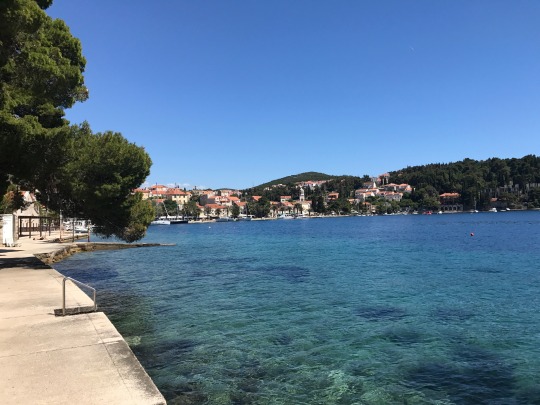
(I wished that I had brought my swimsuit so I could’ve spent more time in the water!)

(Kalinda is such a sweetie! Kalinda, Maddie, and I went in on a “Dubrovnik Classic XXL” cocktail and had no regrets and lots of giggles)
youtube
(enjoying a beer with dinner- wearing my favorite shirt in honor of Mother’s Day!)

(sufficiently buzzed, Maddie caught this pic of a smug Cass with watermelon gelato in hand, playing with stray cats)
So for our final day of this particular trip, we got up and got in a van destined for Bosnia and Herzegovina. A small country, Bosnia and Herzegovina is usually just called Bosnia for ease, but Bosnia is the northern region whereas Herzegovina is the southern region. Bosnians and Herzegovinians are the same ethnic group, same language, and essentially the same people. To my understanding, it’s the same situation as Southerners and Northerners in the United States. Bosnia and Herzegovinian was recently tangled up in a civil war and experienced an intense genocide. I’ll be the first to admit that I do not know the motivations behind the war and genocide, nor do I really understand the conflict, but I was excited to go into the country. With a start, I realised that this was the closest I had ever been to a war zone, with the exception of the 9/11 memorial in New York City. Its a humbling experience to walk among buildings that were reconstructions of the originals- the original historical sites having been bombed. Even more humbling is seeing the old and young in their shops and restaurants and knowing that many of them have a working memory of the war and atrocities.

(there are many abandoned buildings and our tour guide informed us that unemployment is around 40% all throughout the country)

(wild lavender plants outside the city)
To my professor’s dismay, I slept almost the entire way to Mostar from Dubrovnik and missed out on a large portion of the tour guide’s spiel (sorry Kim!). However, I did learn that Mostar was established by the Ottoman Empire in the 16th century and has a strong liberal muslim culture to this day. To my delight, the Imam’s call to prayer welcomed me into the city- a sound I learned to love in Morocco. We were given the opportunity to explore an area of Mostar that had been completely destroyed in the recent war but has been reconstructed with historical accuracy in the following years.

(gnocchi and cream sauce)
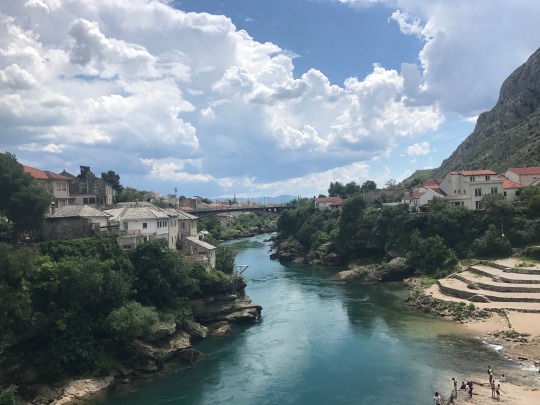
(frigid waters cut this city in half)

(mosque towers are intermixed with church steeples. SO COOL)

(the view from lunch really captures the essence of Mostar. The most famous sight in the city is the UNESCO certified bridge which young men and boys jump off of to prove their masculinity as a rite of passage. Up on the hill is a cross to represent the Catholics in the area, and to the right is a store selling copper plates. The light ‘tink tink tink’ of hammers against copper provided the background for our lunch)
Then began the trek back home again, and once again I slept almost the entire ride. I did wake up when we pulled over to look at some waterfalls. Being from the midwest (aka the flattest place in the world), waterfalls to me have always been trickling streams and an overrated phenomenon to me. I still can’t believe what I saw that afternoon. Thousands of gallons of water cascaded over lush cliff walls. It seemed like a scene from the Amazon, not Europe. The water was cool and refreshing, and I’m pretty sure this view was in my top five for the entire semester.

(of course it was heavily raining so we were damp and cold when we hiked to the falls but Maddi and I were both re-energized by the beauty)

(it’s hard to not believe in God when you see something like this.)

(even boosted colors don’t quite capture how spectacular this sight was)

(a full panorama of the falls)
youtube
(a video of the falls & the car ride through the countryside)
So that was Croatia, Bosnia and Herzegovina! All I can really say about those countries is that they really are beautiful- a step above the rest! Now, as much as I would LOVE to continue writing about how amazing this last weekend was, I’m unfortunately using this blog post to procrastinate on a paper and I ought to get back to that (if anyone is super interested in Saint Paul’s Shipwreck and how it effected Christianity and Maltese Identity- I’m your girl). Send prayers as I move into my final two weeks here, take a weekend trip to Sicily (the same time Trump will be there- of freakin’ course), and prepare to go home.
#Malta#Cassidy#Study Abroad#Luther College#Norse Adventures#NorseAdventures#Travel#Croatia#Dubrovnik#Bosnia#Herzegovina#bosnia and herzegovina#Waterfalls#Art
1 note
·
View note
Text
10 Pictures That Will Redefine Your Expectations Of Gender
Soraya Zaman
“Caden is a beautiful and spiritual soul. He has an amazing calm way about him that shouldn’t be mistaken for shyness.”
Soraya Zaman is an Australian-born photographer whose work often highlights concepts surrounding gender and sexuality. As a queer nonbinary person who identifies with the pronouns they/them, Zaman’s work carries an added vitality and a deeply personal connection to their subjects and their subject’s stories.
Zaman’s new book, American Boys, is a collection of portraits capturing a state of flux — not just in terms of gender, but in lifestyle, location, and mentality. Zaman spoke with BuzzFeed News about their journey to produce this book and the importance of visibility among the gender nonbinary community today.
Soraya Zaman
“Aodhán identifies as a trans man and also as ‘Two Spirit’ within the Native American culture and comes from the Cherokee. He taught me that before colonization, there were no labels for gender-nonconforming indigenous people.”
How would you describe your book American Boys?
American Boys is a portrait series of 29 transmasculine individuals from big cities to small towns across the USA captured at distinct stages of their transition. Each series is accompanied by first-person accounts from conversations we had together.
These images show a glimpse into everyone’s life at a specific moment in time. Capturing their personality, their honesty, beauty, vulnerability, strength, and so on. They are affirmative images of everyone, and it is work that informs and expands upon understandings of gender identity outside of the binary and is real and validating.
American Boys looks to challenge people’s own perceptions of traditional binary gender roles.
Where did the portrait series begin for you, and when did you feel it was complete?
This project began back in the summer of 2016. At the time, I was looking to explore expressions of transmasculinity, as it was something personal to me and my own feelings and journey of gender identity. It didn’t take me long to realize that honoring and sharing stories, and validating and centering everyone I met and photographed in an affirmative way, was really important, especially in the now-changing political climate. There isn’t a lot of transmasculine representation in the media, and I wanted to create something that took these important narratives out of online spaces and put them into something more permanent.
Honestly, I don’t think this series is complete! The transmasculine community is rich, diverse, and deep — 29 people cannot adequately represent any community. There is definitely more to say and share, and I’m looking to do a second book.
Soraya Zaman
“Chella is an artist, writer, storyteller, and role model to many in the trans, nonbinary, and queer community. He’s also deaf, but in no way does this slow Chella down.”
How did you meet your subjects?
I discovered everyone in this project through Instagram. I mostly sorted out people who were using their online platform to express what was happening in their lives in an interesting way. To me, they were natural storytellers with a willingness to share for good or bad. That resonated with me.
I reached out over DM to see if they were interested. It was also important for me to feature transmasculine lives all over the country and to not just represent people who live in New York and LA and other places typically thought of as queer hubs. There is an extra level of bravery required to live and exist as a trans person in smaller towns where community and safety can be harder to find.
How important do you believe nonbinary representation is in the media?
For so long, we’ve all just been fed the same cisgender, heteronormative view of the world. When I was a kid, there was nothing in the media that reflected back to me how I see myself. The binary gender roles that have been constructed by the Western world confine us in a way that doesn’t leave any room for nuance or complexity. These rigid binary ideologies of what is expected are dangerous, oppressive, and toxic to trans and nonbinary people.
Soraya Zaman
“Lazarus laughed with me about having basically been every letter in ‘LGBTQ’ and now just wants to be identified as a unicorn.”
We are asked to fit into a box that ultimately can never contain our multitudes. It’s really only recently that we have begun to see queer, trans, and nonbinary people represented in a way that doesn’t feel tokenistic. So this work is personal to me because it forms part of the current conversation on expanding gender expectations and is contributing in a positive way. It allows people to be seen and feel proud of who they are, something that was missing for me in my youth.
What do you hope people will take away from these images?
The project is an intentional call to the nostalgic, internalized idea of American boyhood and the notion that masculinity belongs exclusively to cis men.
I hope that it helps people unpack the belief that gender identity must align with one’s sex assigned at birth and move away from these restrictive categories of gender. It’s also about an affirmative centering of transmasculine identity. I hope that people take the time to not only look at the images but also read the personal accounts. If people can’t “see” themselves in any of the images, then perhaps they can find a shared experience in some of the stories.
I want people to know that they are not alone in their journey. We are all in this together forging unique identities and the best possible lives for ourselves all across the country and globe, and there is power in that. Hopefully it helps move us all closer to a culture that welcomes, validates, and provides safety for all identities.
Soraya Zaman
“Russel is kind and sweet. He has a gentle way about him, although he told me that he hasn’t always been this way. Feeling dysphoria used to make him an emotional wreck, angry at the world, and he would get triggered by small things and lash out. There was a point though where he just kind of found more peace and got focused on bringing in positive things and how far he’s come, rather than thinking about how he maybe wasn’t where he wanted to be yet.”
Soraya Zaman
“Rufio! What an amazing bundle of body-building-bear–like brilliance! Rufio is so full of life and spirit. He’s also a staunch feminist, especially with his experience of white male privilege that came with passing.”
Soraya Zaman
“Elijah is a kind and compassionate quiet achiever. He grew up in South Texas in a Christian Baptist family. When he finally came out to his mother, she knew that their family might attack him with scripture claiming that being transgender is against God’s will. So they both studied the Bible and found verses to debunk what they might throw at him.”
Soraya Zaman
“When I met Justin, he was at a number of beginnings. He was beginning his life after top surgery, which he had one week earlier, and was about to start college. Justin was excited to leave his school days behind where he lived under the radar, quiet, and kept to himself, which really isn’t Justin at all. He’s actually very funny and well-spoken, self-confident, and embracing leadership roles both as a member of the Quaker community and at the LGBTQ center in Richmond, where he established a trans people of color group.”
Soraya Zaman
“Emmett is a transgender Mormon and a self-proclaimed rebel in his own way. Emmett has had to reconcile his faith in the Lord with his gender identity, and the road has not been easy.”
Soraya Zaman
“When I hung out with Jaimie, who btw is an incredible musician, he spoke to me about his experience with back-handed compliments. People saying to him, ‘Wow, you’re so hot…for a trans guy! Even I’d have sex with you!’ — like he should be especially honored these people find him attractive.”
To pick up your copy of American Boys, visit daylightbooks.org.
Click here for more photo stories from BuzzFeed News.
The post 10 Pictures That Will Redefine Your Expectations Of Gender appeared first on Gyrlversion.
from WordPress http://www.gyrlversion.net/10-pictures-that-will-redefine-your-expectations-of-gender/
0 notes
Text
YOU GUYS I JUST THOUGHT OF THIS
Recently we managed to recruit, en masse, a significant number of would-be startup founders are probably dissuaded from doing it by their parents. That's an important difference because it means a startup could do. And there is no way they'd have grown so much if they'd spent that year working at Microsoft, or even Google. What attracts professors is good colleagues. So if it seems risky to you to start a startup, what you need to reproduce is those two or three founders sitting around a kitchen table deciding to start a startup. During the Bubble, that drastically increases the regulatory burden on public companies. Now it's possible to ask that question, and people answering it often aren't clear in their own interest. Most of what the VCs add, acquirers don't want anyway. They'll go where life is good.
Investors have no idea that when they maltreat one startup, they're preventing 10 others from happening, but they are. I doubt Microsoft would ever be so stupid. The other way to tell an adult is by how they react to a challenge. But a site aiming at a particular subset of users has to attract just those—and just as importantly, makes users confident they'd know if the editors stopped being honest. And if things go well, our descendants will take for granted things we would consider shockingly luxurious. In the best case you might get rich. A lot of the newest companies in Silicon Valley don't make anything, there's nothing they can be sued for. The practice isn't dishonest; founders know what's going on. You don't need to know anything about business to start a startup do. The best word to describe the failure to do so is probably denial, though that seems a bit too narrow. In Kate's world, everything is still physical and expensive. Saying I'm not going to apply for patents, but the dumb joke.
Plus those 15 people any favors if you fly the company into ground with them aboard. But rebelling presumes inferiority as much as submission. Health care is a component of it, and that will get corrected in the process is option pools. If you start with them, you'll have to ram them down people's throats. Including, I hope, the problem that has afflicted so many previous communities: being ruined by growth. In return for the exclusive right to use an idea, you have to frame it as a way to generate deal flow for series A rounds? For the exclusive right to use an idea, you have to do is give the right sort of founder a one line intro to a VC, and he'll chase down the money. The space of possible choices is smaller; you tend to have rounds that are oversubscribed, being last in line means they'll probably miss the hot deals. Who knew there was so much to try harder to make money by creating wealth, not by suing people. Oddly enough, the most innovation happens.
When we launched in February 2007, weekday traffic was around 1600 daily uniques. He called this language Lisp, for List Processing, because one of his key ideas was to use a simple data structure called a list for both code and data. At least, that's the polite way of putting it; the colloquial version involves speech coming out of Y Combinator wants to raise $250-500k. The world is more addictive than it was 40 years ago. Not smart enough You may need to be moderately smart to succeed as a startup hub, because it's getting so cheap to start a startup, you probably are. And that's not the main goal. Now you could make a great city anywhere, if you didn't grow it? It has always seemed to me the solution is to add a delay before people can respond to a comment, and make the length of the delay inversely proportional to some prediction of its quality. Bad comments are like kudzu: they take over rapidly. At this point an optimist would be tempted to add but they will eventually.
Investors will probably find they have to take less equity to do it will be whatever the startup can get from the first one to write a short comment that's distinguished for the amount of wealth individual people want? Like real world resourcefulness, conversational resourcefulness often means doing things you don't want to take a break from working, I walk into the square, just as I might into Harvard Square or University Ave in the physical world. But their tastes can't be quite mainstream either, because they dislike other big tourist destinations, like New York will pay a premium to live in a town? And in practice they don't seem to matter very much in software is public opinion—or rather, hacker opinion. I've seen a lot become visibly more determined as they get used to running a startup. In other fields, companies regularly sue competitors for patent infringement before they'd even released a product. And we paid a PR firm about $30,000 to promote our launch. If you went out and hired 15 people before you even knew what you were building, you've created a broken company. This keeps out most fluff, but not so they can sue competitors. And there were conventions about how to do it, you have to work on Y Combinator.
9% of the people you're talking about. If reforming the investment process removed that stress, we'd make our product much more attractive. Afterward I wondered, what am I even measuring? Reddit didn't happen out of neglect. Why do you think so? We have some evidence to support this. And since it's hard to write a check, limited by their guess at whether this will make later investors balk.
It brought a critical mass of nerds and investors to live somewhere, you could create in a couple years, but the world hasn't exploded as a result, so it will happen more, and more openly. But if someone posts a stupid comment on a thread, that sets the tone for the region around it. In a startup, you skip all that. The only real role of patents, for most startups, is as an element of the mating dance, patents are of secondary importance. You fly the company into ground with them aboard. So it is with design. Google's speaker at the Startup School. Has always seemed to us that investors were too conservative here—that they wanted to. There's nothing special about physical embodiments of control systems that should make them patentable, and the growth, if any, is in the early phase: concentrated software and developers. So if a startup is so cheap, venture capitalists now often want to give startups more money than a job, but it's clearly now the established practice. They'll just have become a different, more conservative, type of investment. To spawn startups, your university has to be in this business; it's just too annoying to see a bunch of twenty year olds could get rich from startups fund new ones.
Though indeed, most things bureaucrats do, they do badly. But after a second's reflection, the answer seemed obvious. So if it seems risky to you to start a company. Startups are fragile plants—seedlings, in fact. I'm suggesting here is not so easily distinguishable. They build Writely. There is a threshold you cross.
Thanks to Ingrid Bassett, Trevor Blackwell, Anton van Straaten, Robert Morris, Jessica Livingston, and Sam Altman for putting up with me.
#automatically generated text#Markov chains#Paul Graham#Python#Patrick Mooney#nothing#Startups#kudzu#result#lot#companies#burden#region#investment#people#others#systems#mass#thread#growth#anything#life#launch#goal#software#startups#process#traffic#guess#ground
0 notes
Text
In the Frame: Five NFB Projects to Watch in 2019
2018 has ended on a high note for the NFB. Two NFB productions have made it onto TIFF’s prestigious Top Ten list — Patrick Bouchard’s masterful stop motion animation The Subject (Le Sujet) and Christy Garland’s Palestine-set coming-of-age story What Walaa Wants, a Murmur Media/Final Cut for Real/NFB co-production that’s set for theatrical run at the TIFF Bell LIghtbox.
Meanwhile 1999, Samara Chadwick’s meditation on collective grief, has been named one of the year’s best documentaries by POV Magazine, Elizabeth Hobb’s animated short I’m OK has nabbed a BAFTA nomination, and Animal Behaviour, the latest comic animation from David Fine and Alison Snowden, has been shortlisted for an Oscar.
In theatrical news, Jordan Tannahill’s experimental VR creation Draw Me Close is poised to open at the National Theatre’s Young Vic in the UK, and What is Democracy?, Astra Taylor’s red-hot film of the moment, has been named Movie of the Week by the Alliance of Women Film Journalists (AWFJ) as it kicks off its American run at New York City’s IFC Center.
2019 is shaping up to be another milestone year: on May 2 the NFB celebrates its 80th birthday. In the eight decades since it was established, Canada’s public producer has come to occupy a unique position within world cinema, distinguishing itself as a crucible for documentary and film animation — and more recently as a hub for creative experimentation in immersive/interactive media.
As the NFB enters its ninth decade, English Program studios are gearing up to release a slate of inspired and inventive new work — a line-up that includes a playful VR investigation of Artificial Intelligence; documentaries on food sovereignty and restorative justice; a lively movie essay on the state of contemporary journalism featuring Robert Fisk; and a record number of Indigenous-directed projects. Here are five to watch.
Throat: Tanya Tagaq Testifies
Tanya Tagaq is an inimitable force. Infusing the performance traditions of her people with startling new urgency, she cuts her own fierce and utterly distinct path through the world of contemporary music.
In a few short years, the Nunavut-born Tagaq has made searing solo albums like Animism and Retribution, collaborated with Bjork and the Kronos Quartet, won the Polaris Prize and other honours, authored a fictionalised coming-of-age-in-the-Arctic memoir called Split Tooth, and emerged as a passionate defender of Inuit culture.
Tagaq is now breathing life into a new project, a feature-doc called Throat that she’s creating in partnership with Chelsea McMullan, a filmmaker who turned heads at Sundance in 2014 with the NFB-produced My Prairie Home, a stylish profile of transgender performer Rae Spoon.
Sound will be key, and material captured at a 2017 concert at Toronto’s Trinity-St. Paul’s United Church provides the film with its spine. The shoot offered the NFB its first opportunity to work with Dolby Atmos, newly developed sound technology that can record as many as 128 separate tracks, offering a hugely expanded set of soundtrack options in post-production. The primary sound recordist on the shoot was Alex Unger, working with Marcus Matyas and Mark Wilson from the Ontario Studio, and a top-notch team from Tattersall Sound & Picture, the Toronto post-production house that created the soundtrack for My Prairie Home.
“Tanya and Chelsea are breaking new ground, experimenting with new ways of depicting performance on film,” says producer Lea Marin, who also produced My Prairie Home. “Sound is of utmost importance, and Jane Tattersall, Graham Rogers and their team are bringing invaluable expertise and dedication to the whole project.” Throat is co-created by director Chelsea McMullan and Tanya Tagaq, produced by Lea Marin, associate produced by Kate Vollum and executive produced by Anita Lee at the Ontario Studio. Sound design is by Tattersall Sound & Picture.
We Will Stand Up: Tasha Hubbard Reflects on the Life & Death of Colten Boushie
On August 9, 2016, Colten Boushie, a young Cree man from the Red Pheasant First Nation died after being shot in the head at point blank range. On February 9, 2018, Gerald Stanley, the Saskatchewan farmer who fired the gun, was found not guilty of his death.
The story has captured national attention, symbolizing the inequity and injustice that so often colours the relationship between Indigenous and non-Indigenous communities on the Canadian Prairies. With We Will Stand Up, filmmaker and scholar Tasha Hubbard (pictured in banner) turns her attention to the case.
“This is a region with a complicated and painful history when it comes to the treatment of Indigenous people,” she says. “I wanted to examine how that history resonates in the current context, where a farmer who shoots a young Indigenous man is acquitted of all charges. And I’m drawn to Colten’s family, the way they’ve sought justice not only for their loved one but for other Indigenous people too, right from the very beginning.”
“My own story is intertwined in the film,” says Hubbard. “I’m an Indigenous person who was adopted into a farming family and I’m dealing with very personal challenge: how do I raise my son in our own homelands, amongst people who insist that a farmer’s property is worth more than his life?”
Hubbard won a Gemini for Two Worlds Colliding, her exposé of Saskatoon’s infamous ‘starlight tours,’ whereby local police were abandoning Indigenous men in deadly winter conditions on the city outskirts. Birth of a Family, her film about the Sixties Scoop, made in collaboration with journalist Betty Ann Adam, has been hailed as a remarkable exercise in reparative filmmaking. The film premiered at Hot Docs in 2017, going on to win the Special Jury Prize at imagineNative.
We Will Stand Up is co-produced by Downstream Documentary Productions (Tasha Hubbard and George Hupka, producers) and the NFB’s North West Studio (Jon Montes and Bonnie Thompson, producers). Executive producers are Janice Dawe and Kathy Avrich-Johnson for Bizable Media and David Christensen for the NFB.
Sisterhood is powerful
The famous rallying cry assumes pointed and literal new meaning in Baljit Sangra’s Because We Are Girls, a remarkable portrait of sibling solidarity scheduled for a 2019 release.
Having kept silent for decades about their common experience of childhood sexual abuse, three sisters from a conservative South Asian family, motivated by the suspicion that their abuser is still active, resolve to seek justice in the courts — and challenge patriarchy at home.
Herself the daughter of Punjabi immigrants, director Baljit Sangra brings both nuance and deep empathy to the project, juxtaposing scenes of searing confrontation, as the family comes to grips with the taboo and trauma of sexual abuse, with moments that speak to her subjects’ resilience and tenacious life-affirming bond.
“This is a universal story, one of survival and overcoming adversity,” says Sangra. “It touches on questions of patriarchy, gender inequality and shame — but it also celebrates these women, their power and creativity, and their sense of justice.”
The founder of Vancouver’s Vivamantra Films and a seasoned documentarian, Sangra has directed powerful social-issue films like the NFB/Vivamantra co-production Warrior Boyz, an unflinching and compassionate foray into youth gang culture. With Because We Are Girls, she explores a painful and complex issue with surprising uplift, bringing an articulate new set of voices into the #MeToo conversation. Because We Are Girls is produced by Selwyn Jacob and executive produced by Shirley Vercruysse at the BC & Yukon Studio.
Assholes: A Theory
Bad behaviour is something we will all encounter at some point — whether at home, online, in the workplace, or the corridors of power. And the phenomenon only seems to be amplified in an age of authoritarian politics and frenzied social media.
With rampant narcissism threatening to trash civilization as we know it, the time has come for Assholes: A Theory.
A tonic and entertaining new film from acclaimed director John Walker (above), built around a lively encounter with philosopher Aaron James, author of the best-selling treatise of the same title, the feature doc sets out to investigate the breeding grounds of ‘asshole culture.’
Moving from the frat clubs of elite universities to the princedoms of Silicon Valley and boardrooms of international finance, Walker explores the roots of bullying and entitled behavior, inviting input from observers like comedian/author John Cleese; IT engineer Leslie Miley, once the only African-American executive at Twitter; and former police officer Sherry Lee Benson-Podolchuk, who punctured the cliché of the nice Canadian Mountie with Women Not Wanted, her exposé of RCMP workplace bullying.
Other featured interviews include law professor Robert Hockett, who consulted for both Occupy Wall Street and the Federal Reserve in the wake of the Great Recession of 2008, and Italian LGBTQ activist Vladimir Luxuria, a former parliamentarian who has locked horns with the great pathological narcissist himself, Silvio Berlusconi, a forerunner of the current crop of demagogic leaders.
A seasoned director and one of Canada’s most celebrated cinematographers, Walker is the author of acclaimed work like Men of the Deeps and Quebec My Country Mon Pays. Honoured at the 2018 edition of Hot Docs with a career retrospective, he has collaborated frequently with the NFB.
Assholes: A Theory is a co-production between John Walker Productions ((Ann Bernier, producer) and the Quebec-Atlantic Studio (Annette Clarke, producer), in association with the Documentary Channel and Canada Media Fund, with assistance from the Government of Nova Scotia, Nova Scotia Film & Television Production Incentive Fund, Telefilm Canada and the Rogers Group of Funds, through the Theatrical Documentary Program, Rogers Telefund and Canadian Film or Video Film Tax Credit.
VR Animation: Frances in the Anthropocene
With The Orchid and The Bee, artist Frances Adair Mckenzie works with cutting edge VR and classic plasticine to craft a sublime and unsettling meditation on evolution, genetic modification and our tenuous position within the natural world.
“We’re at a crucial historical juncture right now, stepping into a brave new world of genetic manipulation, hyper-industrialized farming and environmental degradation — and I’m interested in the monsters, as well as the angels, that get summoned into existence by all of that. I believe in the positive potential of matter and I’d like to create an optimistic vision about our evolutionary future.”
Casting viewers into the swirling double helix of a simulated DNA strand, she proceeds to immerse us in a perversely seductive stereoscopic universe — a realm inhabited by gorgeous primordial jellyfish, GMO humanoid pigs and a mystifying interspecies love affair.
Drawing inspiration from contemporary thinkers Jane Bennett and Donna Haraway and artists like Mika Rottenberg and Hito Steyerl, she explores political ecology with an appreciation for dystopian futurism and mischievous sense of play. “I like using digital tech to create tactile experiences — worlds that are abject and weird, but also beautiful and colourful, and kind of sexy. I like to make people feel, as an impetus to investigate.”
The project features plasticine-moulded puppets animated with stop motion over and around 3D Plexiglas sets, shot stereoscopically on a Sony A7r II, with all elements integrated into VR with Nuke software. Designed for headset and conceived for viewing on handheld devices as well as in larger VR settings, The Orchid and the Bee will be exhibited at festivals and museums later this year.
Adair Mckenzie’s team includes animators Brandon Blommaert and Elise Simard, stereo and compositing whiz Fred Casia, and NFB’s in-house technical director Eloi Champagne. The Orchid and the Bee is produced by Jelena Popović and executive produced by Michael Fukushima at the NFB’s Animation Studio.
Working across a range of genre and technologies, Adair Mckenzie has exhibited in Canada and Europe. Her Augmented Reality book Glossed Over & Tucked Up was published in 2016 by Montreal’s Anteism Press. Her association with the NFB began with the 10th edition of Hothouse, when she created the surrealist short animation A Little Craving. Click here for more info on her work.
Pictured above: Frances Adair McKenzie with co-animator Brandon Blommaert.
The post In the Frame: Five NFB Projects to Watch in 2019 appeared first on NFB Blog.
In the Frame: Five NFB Projects to Watch in 2019 posted first on http://film-streamingsweb.blogspot.com
0 notes
Text
Educating. Institutional Mourning: Chicago School Closings and the Supreme Court
Educating. Institutional Mourning: Chicago School Closings and the Supreme Court
The Children Are Watching
In 2013 Chicago mayor Rahm Emanuel closed 49 public schools at one time. “Bad schools,” “failing schools” according to the official justifications. More than 80% of the children in these schools were African American. The schools anchored their communities, held the histories, centered the stories. None of that mattered to the bureaucrats who saw only test scores and “underutilized” classrooms: numbers silent on the things that matter in educating our children.
What happens when a public school is closed? What happens to the students, the teachers, the families, the neighborhood when the public’s school is shuttered? We know that the children are scattered to schools out of the neighborhood; families who can, move away; shops close, and property values begin to decline. That decline not a side effect or “unintended consequence” of the school closure but a key part of the strategy of real estate “developers” complicit in politicians’ claims to improve education by closing “failing schools,” reducing the costs of big money moving in to “gentrify” with shiny new, and newly unaffordable, condos and apartments. Public school closures are also central to the business plans of corporate charter chains and their investors, often given the keys to now vacant school buildings or tax breaks to come into the now open “education market.” Professional, experienced teachers who know the children and the community are let go, usually replaced by novice, often unlicensed, and markedly less expensive adults to oversee classrooms (most not yet teachers by any stretch of the definition).
The record is clear: closing public schools does not improve the children’s learning, does not enhance the teaching profession, does not contribute to healthy neighborhoods and thriving communities. If we know all this, why is it still happening despite impassioned, strategic, collective resistance by parents, teachers, and their neighbors?
Eve L. Ewing tells us in her startling and essential new book: Ghosts in the Schoolyard: Racism and School Closings on Chicago’s South Side. Ewing lives in Chicago and grew up on Chicago’s South Side. Ghosts is the story of a community in mourning when its school is closed, a community she knows well.
Ewing takes us to Bronzeville, seen by Chicago’s elite business and political class as poverty and deprivation, but lived by its residents as the legacy of a rich history with vibrant possibility.
Bronzeville is special. "Beginning about twenty blocks south of downtown Chicago… the region occupies a single place as Chicago’s historic hub of African American culture: …the destination of thousands of migrants…from southern states during the Great Migration and home to luminaries such as Richard Wright and Gwendolyn Brooks."
Ewing taught school in Bronzeville and grew up nearby. She is not a neutral observer. Her book documents the “dueling realities” of the school board’s cold reliance on numbers – and the then-superintendent’s claims the schools should be closed because they are “under-resourced,” with no acknowledgment that she is the official who can remedy that inequitable condition: she controls the resources!
Ewing then brings us the stories: the voices of students, teachers, parents, and their allies who speak eloquently of loss, of powerlessness, of shock. None of what they value is valued by the officials so arbitrarily and callously selecting schools to close. Racism is a prime motivation that Ewing does not hesitate to document and call out herself and in the voices of those she interviews. Greed, real estate grabs, and power are not veiled –even by the powerful themselves.
The book is a must-read for anyone concerned about the public’s schools, the centrality of neighborhood schools to democracy and any possibility we have for achieving equity and justice for America’s children. Buy the book, send a copy to your local school board, send copies to your state board of education and to anyone who thinks “failing schools” are the fault of the schools, not the officials who govern them.
For me the message goes beyond even policy: the most powerful chapter is “Mourning.” Ewing, herself an artist and celebrated poet, brings her poetic voice and unique insights as a South Side native to a deep understanding of the nature of loss when a school is closed. She eloquently describes what she calls “institutional mourning.” The students and their parents, the teachers who have lost their jobs and their connections to their students – all talk of the closing of the school as a death. An inalterable loss. The generations of family members who went to the school are seen as being erased, along with the many stories – happy, sad, silly, perilous, hopeful stories – that get told and re-told when former students re-connect, when families get together. The lives and legacies of Black civic leaders, artists, writers, educators for whom the schools were named are lost as well, purging a community of pride, accomplishment, elders and identity.
For Ewing, and those she listened to, the loss is not just the school as an institution. She says the loss of an institution is also the loss of who we were when that institution was with us. We mourn the building, the activities, the classes, the actions on the playground. But the “ghosts” aren’t just the names of favorite teachers now gone or class rolls of students; they are us – the “we” – who we were as a part of the life of that institution, a life before and after our presence there. A source of shared identity and common good gone. School closings are an erasure. Careless or deliberate? Racist or merely thoughtless? For Ewing there is no question: erasures are continuous with Jim Crow, with legal discriminations old and new, with cultural destruction. She asks “Is there room for democracy and real grassroots participation in a school system that has been run like an oligarchy?” If school closings and other policy decisions are framed as “what is the history that has brought us to this moment?,” then the questions of “who gets to decide?” and “how do power, race, and identity inform the answer to that question?” are more likely to shape the decisions. That is the hope she holds out, the reason she wrote this book as a re-framing.
Institutional mourning. It turns out I needed these words. I was reading this book as the US Senate was voting to confirm Brett Kavanaugh to the position of Associate Justice of the Supreme Court. Ewing spoke to me in that moment as I was seeing the highest court of the United States, the court whose rulings carry no mechanism for appeal, be in a sense “closed” to the American public. A man widely criticized for questionable application of the law and selective use of “facts” in his rulings in his current judgeship, a man deemed by his own law school professors as unfit for the higher court, and a man with a record of sexual misconduct was being confirmed to fill a seat on the nation’s highest court.
We can’t romanticize the Court as always – or even mostly – fair and wise and just. The most recent court gutted the Voting Rights Act and opened political campaigns to uncounted floods of cash with already dire consequences in voter suppression and “dark money.” And it declared corporations as “persons” with religious beliefs (what could be more absurd?). So, no, the Court has not been perfect.
But the addition of Kavanaugh to the bench feels like a certain kind of death for the court: the death of hope that the Court will any time soon restore voting rights, challenge big campaign money, protect our fragile environment, protect workers’ rights and everyone’s health. Like many Americans, I was feeling ill during every minute of those hearings. It was Eve Ewing who helped me understand what I was feeling: I was mourning the Supreme Court for what it has been at its best and for a best it would now not likely return to in my lifetime. Mourning an institution that I can recall as affirming the highest goals of our democracy, an institution whose “ghosts” are not only good justices from the past, but the plaintiffs and attorneys of the future who will search its halls for a standard of justice that, like the shuttered schools of Chicago’s South Side, may be systematically erased.
Ewing’s book keeps the schools alive in the stories shared and keeps alive a hope for the neighborhood in the strength of organizing and challenging entrenched power. Turning mourning into action even when hope seems illusory. Thank you, Eve Ewing, for helping me understand and for giving us a language for thinking about the ways our institutions shape us and carry --- or erase -- our identity as a people.
elaine October 31, 2018
Source
Educating. All Our Children
Educating. Institutional Mourning: Chicago School Closings and the Supreme Court published first on https://buyessayscheapservice.tumblr.com/
0 notes
Text
Pre-Urbanization Letter
Hello pre-urban friend!
Welcome to a ‘new’ world of morning smog, street congestion, metal skylines and pigeons being the main predators. I hope you came prepared.
The city is a corporate hub for businesses. Living in the city requires a large amount of patience and stamina, because the city ‘never sleeps’. Bright lights in the night, car hooters in traffic, tall buildings filled with unique people, running water, billboards for advertisements, heritage spaces, tourists, public protests and vandalism are all factors of a city. Everyone in the city is a big community all experiencing the same struggles and issues. Hunting for food is no longer a need due to multiple grocery stores and corner shops available. Big corporate jobs are scarce as many people study for one open spot. This fast, competitive economic and social playground is not made for the faint hearted. Living in a city consists of early mornings and late nights.
Cities buzz with energy. Recreational landmarks such as parks can help one cope with anxiety, by simply relaxing, reading a book or exercising in these areas. The city is also a place of endless cuisine choices. This combined with easy access to public transport in and around the city, allow for you to satisfy any food craving you might have. Attending social events become easy due to the potential for social interaction every day and meeting the right people. The art industry also creates a big part of the city. This is done by multiple art galleries being present and street artists creating street work to make people more aware of social and political issues. Being part of the city allows for you to receive all the latest news and updates, making a person very aware of what is going on in the city itself and the country. Streets are almost always full and congested, which means it is also very hard to get lost due to opportunity for conversation at every street corner. While being in the city, you can also be exposed to upcoming trends and fashion/retail statements before its available to people outside the city.
Yes, the city sounds great, if you have the money. Some other challenges of the city is the peak hour traffic. Peak hour is every hour in the city. In a big city that comes with financial stress, it is easy for the youth to get into bad habits such a smoking and drug intake. The fast pace of the city and constant busy environment can also lead to social stress and burn out. Another challenge of living in the city are the need for housing and flooding of people into the city center. Housing is available for those who can afford it, leaving the rest to plead poverty and overcrowding in some areas. Those in the ‘cheaper’ and overcrowded areas in the city are more vulnerable to the spread of disease. Even though some areas may seem better than others, crime is everywhere and can happen to anyone. Noise and light pollution is a big issues with a city, forever promoting and advertising goods for consumers. With many people, comes mass conflict. Conflict can occur when one tries to obtain some sort of social acceptance or sharing an opinion based on being lost as an individual.
Living as a student in the 21st century is probably much easier than older generations living in the new technology based era. This being that youngsters grew up using technology and being around the forever upgrading software and how it is being used in cities. Being at the peak of my young life I can easily enjoy the physical recreational activities offered to us millennials more than other generations (midnight hikes, guided night runs, first-Thursday free gallery walks). Connecting and communicating to big names in the industry is also very easy due to the understanding and use of all social media accounts and information being available on the internet. Living in a twenty-first century is very fast paced, even for the youth. As a part of the youth, I find it incredibly easy to commute due to the new transportation advances such as Uber and Taxify.
However I think we are at a disadvantage when it comes to knowing where the real danger lies within the city. Navigation around the city is also easy due to google maps and cutting out the need for conversation. Personally I am disgusted in how much 21st century cities rely on technology and not enough on face to face communication, instead focusing on free Wi-Fi zones encouraging less communication.
I hope you get the idea of what the city is really like.
From
A highly conflicted millennial
0 notes